Quick filters:
Slime moulds myxomycetes Stock Photos and Images
 Slime Mould Tubifera ferruginosa a.k.a. T. arachnoidea Stock Photohttps://www.alamy.com/image-license-details/?v=1https://www.alamy.com/slime-mould-tubifera-ferruginosa-aka-t-arachnoidea-image62186290.html
Slime Mould Tubifera ferruginosa a.k.a. T. arachnoidea Stock Photohttps://www.alamy.com/image-license-details/?v=1https://www.alamy.com/slime-mould-tubifera-ferruginosa-aka-t-arachnoidea-image62186290.htmlRMDH4R6X–Slime Mould Tubifera ferruginosa a.k.a. T. arachnoidea
 Sulphur Slime Fungus (Fuligo septica), slime mould on dead wood, Germany Stock Photohttps://www.alamy.com/image-license-details/?v=1https://www.alamy.com/stock-photo-sulphur-slime-fungus-fuligo-septica-slime-mould-on-dead-wood-germany-47923302.html
Sulphur Slime Fungus (Fuligo septica), slime mould on dead wood, Germany Stock Photohttps://www.alamy.com/image-license-details/?v=1https://www.alamy.com/stock-photo-sulphur-slime-fungus-fuligo-septica-slime-mould-on-dead-wood-germany-47923302.htmlRMCNY2JE–Sulphur Slime Fungus (Fuligo septica), slime mould on dead wood, Germany
 Slime mould (Fugio septica) growing on decaying birch stump, Annafarriff Wood NNR, Peatlands, County Armagh, Northern Ireland, June Stock Photohttps://www.alamy.com/image-license-details/?v=1https://www.alamy.com/slime-mould-fugio-septica-growing-on-decaying-birch-stump-annafarriff-wood-nnr-peatlands-county-armagh-northern-ireland-june-image262949691.html
Slime mould (Fugio septica) growing on decaying birch stump, Annafarriff Wood NNR, Peatlands, County Armagh, Northern Ireland, June Stock Photohttps://www.alamy.com/image-license-details/?v=1https://www.alamy.com/slime-mould-fugio-septica-growing-on-decaying-birch-stump-annafarriff-wood-nnr-peatlands-county-armagh-northern-ireland-june-image262949691.htmlRMW7PB0B–Slime mould (Fugio septica) growing on decaying birch stump, Annafarriff Wood NNR, Peatlands, County Armagh, Northern Ireland, June
 Dog Vomit Slime Mold (Fuligo septica) Stock Photohttps://www.alamy.com/image-license-details/?v=1https://www.alamy.com/dog-vomit-slime-mold-fuligo-septica-image258969961.html
Dog Vomit Slime Mold (Fuligo septica) Stock Photohttps://www.alamy.com/image-license-details/?v=1https://www.alamy.com/dog-vomit-slime-mold-fuligo-septica-image258969961.htmlRMW192R5–Dog Vomit Slime Mold (Fuligo septica)
 Slime mold under the microscope, vertical filed of view is about 1.2mm Stock Photohttps://www.alamy.com/image-license-details/?v=1https://www.alamy.com/slime-mold-under-the-microscope-vertical-filed-of-view-is-about-12mm-image424620002.html
Slime mold under the microscope, vertical filed of view is about 1.2mm Stock Photohttps://www.alamy.com/image-license-details/?v=1https://www.alamy.com/slime-mold-under-the-microscope-vertical-filed-of-view-is-about-12mm-image424620002.htmlRM2FJR342–Slime mold under the microscope, vertical filed of view is about 1.2mm
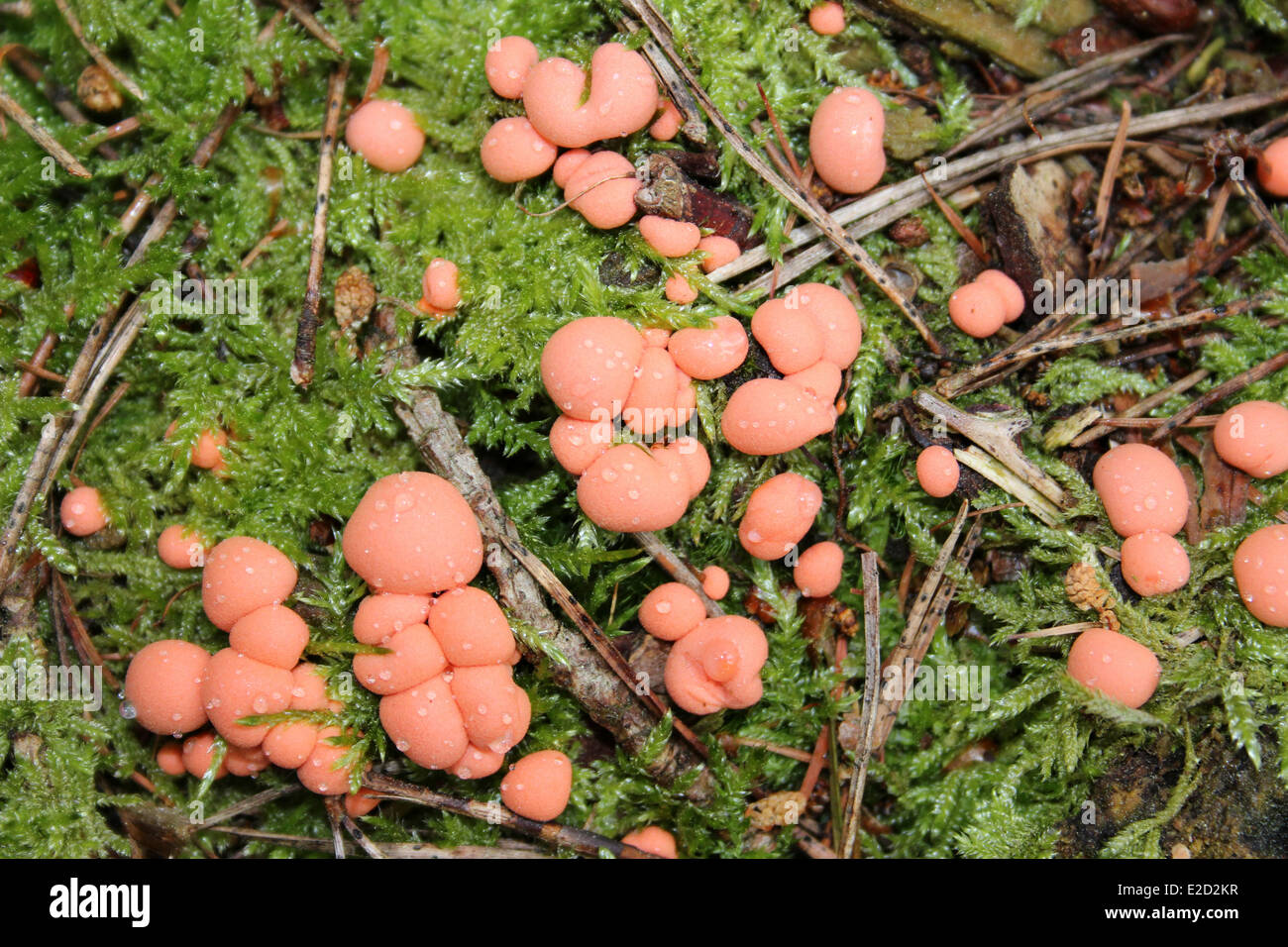 Wolf's Milk Slime Mould Lycogala terrestre Stock Photohttps://www.alamy.com/image-license-details/?v=1https://www.alamy.com/stock-photo-wolfs-milk-slime-mould-lycogala-terrestre-70358283.html
Wolf's Milk Slime Mould Lycogala terrestre Stock Photohttps://www.alamy.com/image-license-details/?v=1https://www.alamy.com/stock-photo-wolfs-milk-slime-mould-lycogala-terrestre-70358283.htmlRME2D2KR–Wolf's Milk Slime Mould Lycogala terrestre
 Slime mold, about 1.3mm in height, likely Didymium nigripes or similar Didymium sp. Stock Photohttps://www.alamy.com/image-license-details/?v=1https://www.alamy.com/slime-mold-about-13mm-in-height-likely-didymium-nigripes-or-similar-didymium-sp-image350842273.html
Slime mold, about 1.3mm in height, likely Didymium nigripes or similar Didymium sp. Stock Photohttps://www.alamy.com/image-license-details/?v=1https://www.alamy.com/slime-mold-about-13mm-in-height-likely-didymium-nigripes-or-similar-didymium-sp-image350842273.htmlRM2BAP6W5–Slime mold, about 1.3mm in height, likely Didymium nigripes or similar Didymium sp.
 False Puffball (Enteridium lycoperdon) Stock Photohttps://www.alamy.com/image-license-details/?v=1https://www.alamy.com/stock-photo-false-puffball-enteridium-lycoperdon-35293285.html
False Puffball (Enteridium lycoperdon) Stock Photohttps://www.alamy.com/image-license-details/?v=1https://www.alamy.com/stock-photo-false-puffball-enteridium-lycoperdon-35293285.htmlRMC1BMXD–False Puffball (Enteridium lycoperdon)
 Yellow slime mold under the microscope, horizontal filed of view is about 3mm Stock Photohttps://www.alamy.com/image-license-details/?v=1https://www.alamy.com/yellow-slime-mold-under-the-microscope-horizontal-filed-of-view-is-about-3mm-image429191695.html
Yellow slime mold under the microscope, horizontal filed of view is about 3mm Stock Photohttps://www.alamy.com/image-license-details/?v=1https://www.alamy.com/yellow-slime-mold-under-the-microscope-horizontal-filed-of-view-is-about-3mm-image429191695.htmlRM2FX7AAR–Yellow slime mold under the microscope, horizontal filed of view is about 3mm
 Wolf's milk slime balls (Lycogale terrestre), alongside a clump of Pixie cup lichen (Cladonia fimbriata) on a mossy log. Stock Photohttps://www.alamy.com/image-license-details/?v=1https://www.alamy.com/stock-photo-wolfs-milk-slime-balls-lycogale-terrestre-alongside-a-clump-of-pixie-83300093.html
Wolf's milk slime balls (Lycogale terrestre), alongside a clump of Pixie cup lichen (Cladonia fimbriata) on a mossy log. Stock Photohttps://www.alamy.com/image-license-details/?v=1https://www.alamy.com/stock-photo-wolfs-milk-slime-balls-lycogale-terrestre-alongside-a-clump-of-pixie-83300093.htmlRMEREJ39–Wolf's milk slime balls (Lycogale terrestre), alongside a clump of Pixie cup lichen (Cladonia fimbriata) on a mossy log.
 Carnival Candy Slime Mold Arcyria incarnata Taken at Eastham Country Park, Wirral, UK Stock Photohttps://www.alamy.com/image-license-details/?v=1https://www.alamy.com/stock-photo-carnival-candy-slime-mold-arcyria-incarnata-taken-at-eastham-country-31923017.html
Carnival Candy Slime Mold Arcyria incarnata Taken at Eastham Country Park, Wirral, UK Stock Photohttps://www.alamy.com/image-license-details/?v=1https://www.alamy.com/stock-photo-carnival-candy-slime-mold-arcyria-incarnata-taken-at-eastham-country-31923017.htmlRMBRX63N–Carnival Candy Slime Mold Arcyria incarnata Taken at Eastham Country Park, Wirral, UK
 Wolf's milk slime balls (Lycogale terrestre), the spore forming reproductive phase of this slime mould, on a mossy log. Stock Photohttps://www.alamy.com/image-license-details/?v=1https://www.alamy.com/stock-photo-wolfs-milk-slime-balls-lycogale-terrestre-the-spore-forming-reproductive-83300145.html
Wolf's milk slime balls (Lycogale terrestre), the spore forming reproductive phase of this slime mould, on a mossy log. Stock Photohttps://www.alamy.com/image-license-details/?v=1https://www.alamy.com/stock-photo-wolfs-milk-slime-balls-lycogale-terrestre-the-spore-forming-reproductive-83300145.htmlRMEREJ55–Wolf's milk slime balls (Lycogale terrestre), the spore forming reproductive phase of this slime mould, on a mossy log.
 Stemonitis fusca, known as tube slime mold Stock Photohttps://www.alamy.com/image-license-details/?v=1https://www.alamy.com/stemonitis-fusca-known-as-tube-slime-mold-image330919558.html
Stemonitis fusca, known as tube slime mold Stock Photohttps://www.alamy.com/image-license-details/?v=1https://www.alamy.com/stemonitis-fusca-known-as-tube-slime-mold-image330919558.htmlRF2A6AK7J–Stemonitis fusca, known as tube slime mold
 Slime mold Fuligo septica (dog vomit fungus) in a forest in Western WA, USA Stock Photohttps://www.alamy.com/image-license-details/?v=1https://www.alamy.com/slime-mold-fuligo-septica-dog-vomit-fungus-in-a-forest-in-western-image158111279.html
Slime mold Fuligo septica (dog vomit fungus) in a forest in Western WA, USA Stock Photohttps://www.alamy.com/image-license-details/?v=1https://www.alamy.com/slime-mold-fuligo-septica-dog-vomit-fungus-in-a-forest-in-western-image158111279.htmlRFK56GFB–Slime mold Fuligo septica (dog vomit fungus) in a forest in Western WA, USA
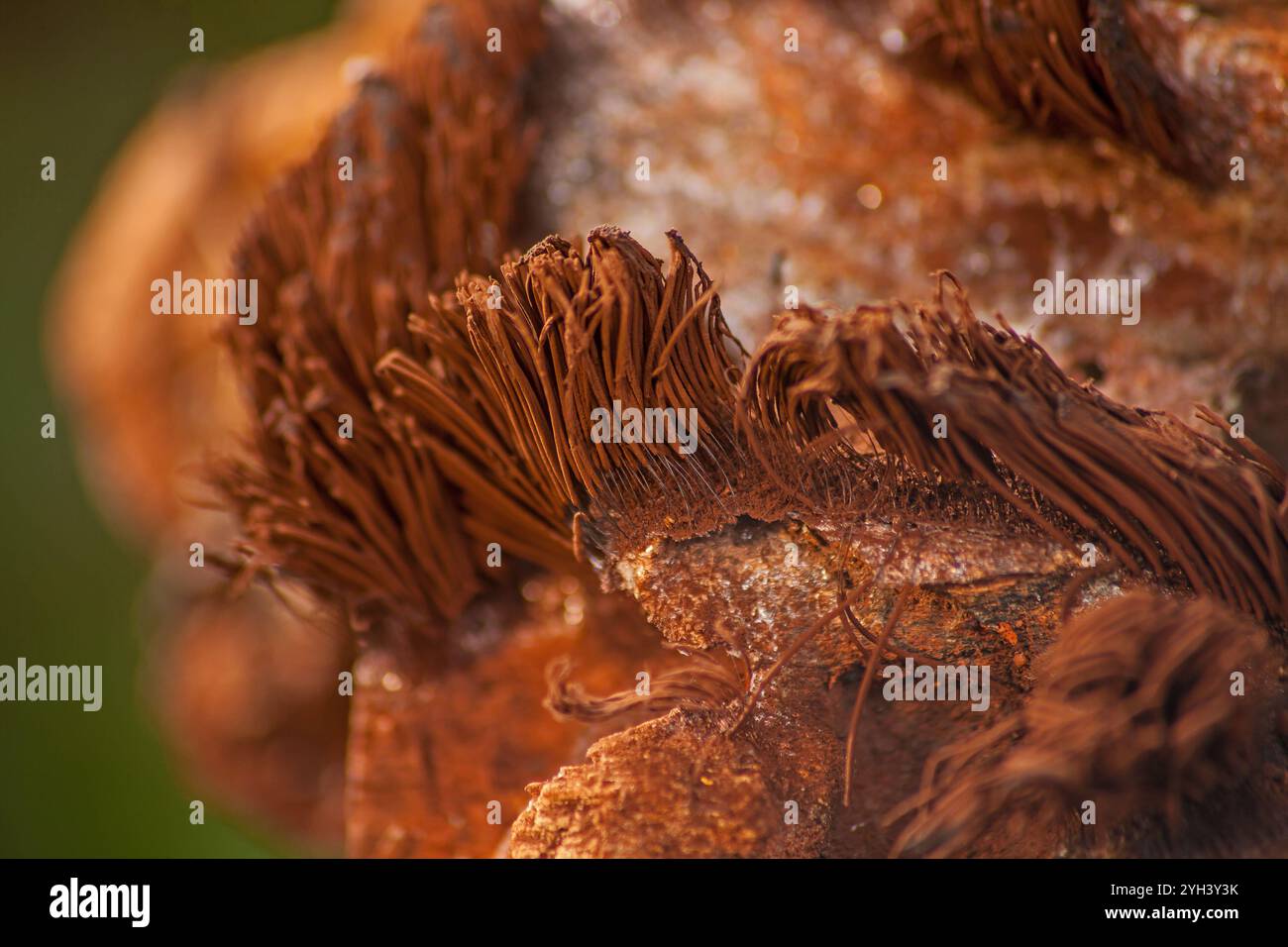 Slime mold Genus Stemonitis 15377 Stock Photohttps://www.alamy.com/image-license-details/?v=1https://www.alamy.com/slime-mold-genus-stemonitis-15377-image630109527.html
Slime mold Genus Stemonitis 15377 Stock Photohttps://www.alamy.com/image-license-details/?v=1https://www.alamy.com/slime-mold-genus-stemonitis-15377-image630109527.htmlRF2YH3Y3K–Slime mold Genus Stemonitis 15377
 A slime mould or myxomycete (Lindbladia effusa var simplex) fruiting bodies forming on a fallen tree, UK. Stock Photohttps://www.alamy.com/image-license-details/?v=1https://www.alamy.com/stock-photo-a-slime-mould-or-myxomycete-lindbladia-effusa-var-simplex-fruiting-31472888.html
A slime mould or myxomycete (Lindbladia effusa var simplex) fruiting bodies forming on a fallen tree, UK. Stock Photohttps://www.alamy.com/image-license-details/?v=1https://www.alamy.com/stock-photo-a-slime-mould-or-myxomycete-lindbladia-effusa-var-simplex-fruiting-31472888.htmlRMBR5KYM–A slime mould or myxomycete (Lindbladia effusa var simplex) fruiting bodies forming on a fallen tree, UK.
 . A text-book of mycology and plant pathology . Plant diseases; Fungi in agriculture; Plant diseases; Fungi. SLIME MOULDS (mYXOMYCETES) 17 the number (8) of chromosomes immediately precedes the formation of the sporangia. The reduction division, which results in the forma- tion of spores, is preceded by synapsis, diakinesis and heterotypic nuclear division. Small nuclei and large nuclei are seen. The large nuclei are probably fusion nuclei. The small nuclei probably disintegrate. To the order Myxogastrales belong the majority of the Myxo- MYCETES (Figs. 2 and 3). Many are found on deca)fing wo Stock Photohttps://www.alamy.com/image-license-details/?v=1https://www.alamy.com/a-text-book-of-mycology-and-plant-pathology-plant-diseases-fungi-in-agriculture-plant-diseases-fungi-slime-moulds-myxomycetes-17-the-number-8-of-chromosomes-immediately-precedes-the-formation-of-the-sporangia-the-reduction-division-which-results-in-the-forma-tion-of-spores-is-preceded-by-synapsis-diakinesis-and-heterotypic-nuclear-division-small-nuclei-and-large-nuclei-are-seen-the-large-nuclei-are-probably-fusion-nuclei-the-small-nuclei-probably-disintegrate-to-the-order-myxogastrales-belong-the-majority-of-the-myxo-mycetes-figs-2-and-3-many-are-found-on-decafing-wo-image232034665.html
. A text-book of mycology and plant pathology . Plant diseases; Fungi in agriculture; Plant diseases; Fungi. SLIME MOULDS (mYXOMYCETES) 17 the number (8) of chromosomes immediately precedes the formation of the sporangia. The reduction division, which results in the forma- tion of spores, is preceded by synapsis, diakinesis and heterotypic nuclear division. Small nuclei and large nuclei are seen. The large nuclei are probably fusion nuclei. The small nuclei probably disintegrate. To the order Myxogastrales belong the majority of the Myxo- MYCETES (Figs. 2 and 3). Many are found on deca)fing wo Stock Photohttps://www.alamy.com/image-license-details/?v=1https://www.alamy.com/a-text-book-of-mycology-and-plant-pathology-plant-diseases-fungi-in-agriculture-plant-diseases-fungi-slime-moulds-myxomycetes-17-the-number-8-of-chromosomes-immediately-precedes-the-formation-of-the-sporangia-the-reduction-division-which-results-in-the-forma-tion-of-spores-is-preceded-by-synapsis-diakinesis-and-heterotypic-nuclear-division-small-nuclei-and-large-nuclei-are-seen-the-large-nuclei-are-probably-fusion-nuclei-the-small-nuclei-probably-disintegrate-to-the-order-myxogastrales-belong-the-majority-of-the-myxo-mycetes-figs-2-and-3-many-are-found-on-decafing-wo-image232034665.htmlRMRDE2G9–. A text-book of mycology and plant pathology . Plant diseases; Fungi in agriculture; Plant diseases; Fungi. SLIME MOULDS (mYXOMYCETES) 17 the number (8) of chromosomes immediately precedes the formation of the sporangia. The reduction division, which results in the forma- tion of spores, is preceded by synapsis, diakinesis and heterotypic nuclear division. Small nuclei and large nuclei are seen. The large nuclei are probably fusion nuclei. The small nuclei probably disintegrate. To the order Myxogastrales belong the majority of the Myxo- MYCETES (Figs. 2 and 3). Many are found on deca)fing wo
 . A text-book of mycology and plant pathology . Plant diseases; Fungi in agriculture; Plant diseases; Fungi. SLIME MOULDS (mYXOMYCETES) 17 the number (8) of chromosomes immediately precedes the formation of the sporangia. The reduction division, which results in the forma- tion of spores, is preceded by synapsis, diakinesis and heterotypic nuclear division. Small nuclei and large nuclei are seen. The large nuclei are probably fusion nuclei. The small nuclei probably disintegrate. To the order Myxogastrales belong the majority of the Myxo- MYCETES (Figs. 2 and 3). Many are found on deca)fing wo Stock Photohttps://www.alamy.com/image-license-details/?v=1https://www.alamy.com/a-text-book-of-mycology-and-plant-pathology-plant-diseases-fungi-in-agriculture-plant-diseases-fungi-slime-moulds-myxomycetes-17-the-number-8-of-chromosomes-immediately-precedes-the-formation-of-the-sporangia-the-reduction-division-which-results-in-the-forma-tion-of-spores-is-preceded-by-synapsis-diakinesis-and-heterotypic-nuclear-division-small-nuclei-and-large-nuclei-are-seen-the-large-nuclei-are-probably-fusion-nuclei-the-small-nuclei-probably-disintegrate-to-the-order-myxogastrales-belong-the-majority-of-the-myxo-mycetes-figs-2-and-3-many-are-found-on-decafing-wo-image216457923.html
. A text-book of mycology and plant pathology . Plant diseases; Fungi in agriculture; Plant diseases; Fungi. SLIME MOULDS (mYXOMYCETES) 17 the number (8) of chromosomes immediately precedes the formation of the sporangia. The reduction division, which results in the forma- tion of spores, is preceded by synapsis, diakinesis and heterotypic nuclear division. Small nuclei and large nuclei are seen. The large nuclei are probably fusion nuclei. The small nuclei probably disintegrate. To the order Myxogastrales belong the majority of the Myxo- MYCETES (Figs. 2 and 3). Many are found on deca)fing wo Stock Photohttps://www.alamy.com/image-license-details/?v=1https://www.alamy.com/a-text-book-of-mycology-and-plant-pathology-plant-diseases-fungi-in-agriculture-plant-diseases-fungi-slime-moulds-myxomycetes-17-the-number-8-of-chromosomes-immediately-precedes-the-formation-of-the-sporangia-the-reduction-division-which-results-in-the-forma-tion-of-spores-is-preceded-by-synapsis-diakinesis-and-heterotypic-nuclear-division-small-nuclei-and-large-nuclei-are-seen-the-large-nuclei-are-probably-fusion-nuclei-the-small-nuclei-probably-disintegrate-to-the-order-myxogastrales-belong-the-majority-of-the-myxo-mycetes-figs-2-and-3-many-are-found-on-decafing-wo-image216457923.htmlRMPG4E83–. A text-book of mycology and plant pathology . Plant diseases; Fungi in agriculture; Plant diseases; Fungi. SLIME MOULDS (mYXOMYCETES) 17 the number (8) of chromosomes immediately precedes the formation of the sporangia. The reduction division, which results in the forma- tion of spores, is preceded by synapsis, diakinesis and heterotypic nuclear division. Small nuclei and large nuclei are seen. The large nuclei are probably fusion nuclei. The small nuclei probably disintegrate. To the order Myxogastrales belong the majority of the Myxo- MYCETES (Figs. 2 and 3). Many are found on deca)fing wo
 Group of a slime mold - Stemonitis fusca. It fruits in clusters on dead wood and has distinctive tall brown sporangia supported on slender stalks with Stock Photohttps://www.alamy.com/image-license-details/?v=1https://www.alamy.com/group-of-a-slime-mold-stemonitis-fusca-it-fruits-in-clusters-on-dead-wood-and-has-distinctive-tall-brown-sporangia-supported-on-slender-stalks-with-image622199057.html
Group of a slime mold - Stemonitis fusca. It fruits in clusters on dead wood and has distinctive tall brown sporangia supported on slender stalks with Stock Photohttps://www.alamy.com/image-license-details/?v=1https://www.alamy.com/group-of-a-slime-mold-stemonitis-fusca-it-fruits-in-clusters-on-dead-wood-and-has-distinctive-tall-brown-sporangia-supported-on-slender-stalks-with-image622199057.htmlRF2Y47H6W–Group of a slime mold - Stemonitis fusca. It fruits in clusters on dead wood and has distinctive tall brown sporangia supported on slender stalks with
 Myxomycetes slime mold fruit fruiting body white grassland nature natural wild wildlife environment environmental europe Stock Photohttps://www.alamy.com/image-license-details/?v=1https://www.alamy.com/stock-photo-myxomycetes-slime-mold-fruit-fruiting-body-white-grassland-nature-33118682.html
Myxomycetes slime mold fruit fruiting body white grassland nature natural wild wildlife environment environmental europe Stock Photohttps://www.alamy.com/image-license-details/?v=1https://www.alamy.com/stock-photo-myxomycetes-slime-mold-fruit-fruiting-body-white-grassland-nature-33118682.htmlRMBWTK62–Myxomycetes slime mold fruit fruiting body white grassland nature natural wild wildlife environment environmental europe
 Sulphur Slime Fungus (Fuligo septica), slime mould on dead wood, Germany Stock Photohttps://www.alamy.com/image-license-details/?v=1https://www.alamy.com/stock-photo-sulphur-slime-fungus-fuligo-septica-slime-mould-on-dead-wood-germany-47923299.html
Sulphur Slime Fungus (Fuligo septica), slime mould on dead wood, Germany Stock Photohttps://www.alamy.com/image-license-details/?v=1https://www.alamy.com/stock-photo-sulphur-slime-fungus-fuligo-septica-slime-mould-on-dead-wood-germany-47923299.htmlRMCNY2JB–Sulphur Slime Fungus (Fuligo septica), slime mould on dead wood, Germany
 Slime mould (Fugio septica) growing on decaying birch stump, Annafarriff Wood NNR, Peatlands, County Armagh, Northern Ireland, June Stock Photohttps://www.alamy.com/image-license-details/?v=1https://www.alamy.com/slime-mould-fugio-septica-growing-on-decaying-birch-stump-annafarriff-wood-nnr-peatlands-county-armagh-northern-ireland-june-image262949695.html
Slime mould (Fugio septica) growing on decaying birch stump, Annafarriff Wood NNR, Peatlands, County Armagh, Northern Ireland, June Stock Photohttps://www.alamy.com/image-license-details/?v=1https://www.alamy.com/slime-mould-fugio-septica-growing-on-decaying-birch-stump-annafarriff-wood-nnr-peatlands-county-armagh-northern-ireland-june-image262949695.htmlRMW7PB0F–Slime mould (Fugio septica) growing on decaying birch stump, Annafarriff Wood NNR, Peatlands, County Armagh, Northern Ireland, June
 Dog vomit slime, Scrambled egg slime (Fuligo septica), at frond, Germany Stock Photohttps://www.alamy.com/image-license-details/?v=1https://www.alamy.com/stock-photo-dog-vomit-slime-scrambled-egg-slime-fuligo-septica-at-frond-germany-76065175.html
Dog vomit slime, Scrambled egg slime (Fuligo septica), at frond, Germany Stock Photohttps://www.alamy.com/image-license-details/?v=1https://www.alamy.com/stock-photo-dog-vomit-slime-scrambled-egg-slime-fuligo-septica-at-frond-germany-76065175.htmlRMEBN1WB–Dog vomit slime, Scrambled egg slime (Fuligo septica), at frond, Germany
 Slime Mould (Mucilago crustacea) at the plasmodium stage of its lifecycle, on wet grass. Peak District National Park, Derbyshire, UK, September. Stock Photohttps://www.alamy.com/image-license-details/?v=1https://www.alamy.com/slime-mould-mucilago-crustacea-at-the-plasmodium-stage-of-its-lifecycle-on-wet-grass-peak-district-national-park-derbyshire-uk-september-image262924012.html
Slime Mould (Mucilago crustacea) at the plasmodium stage of its lifecycle, on wet grass. Peak District National Park, Derbyshire, UK, September. Stock Photohttps://www.alamy.com/image-license-details/?v=1https://www.alamy.com/slime-mould-mucilago-crustacea-at-the-plasmodium-stage-of-its-lifecycle-on-wet-grass-peak-district-national-park-derbyshire-uk-september-image262924012.htmlRMW7N678–Slime Mould (Mucilago crustacea) at the plasmodium stage of its lifecycle, on wet grass. Peak District National Park, Derbyshire, UK, September.
 Scrambled egg slime, Flowers of tan (Fuligo septica), on moss, Germany, Bavaria, Oberbayern-Ammergebirge Stock Photohttps://www.alamy.com/image-license-details/?v=1https://www.alamy.com/stock-photo-scrambled-egg-slime-flowers-of-tan-fuligo-septica-on-moss-germany-97239692.html
Scrambled egg slime, Flowers of tan (Fuligo septica), on moss, Germany, Bavaria, Oberbayern-Ammergebirge Stock Photohttps://www.alamy.com/image-license-details/?v=1https://www.alamy.com/stock-photo-scrambled-egg-slime-flowers-of-tan-fuligo-septica-on-moss-germany-97239692.htmlRMFJ5J64–Scrambled egg slime, Flowers of tan (Fuligo septica), on moss, Germany, Bavaria, Oberbayern-Ammergebirge
 Slime Mold (Trichia decipiens) fruiting bodies grow on a rotting tree. Stock Photohttps://www.alamy.com/image-license-details/?v=1https://www.alamy.com/slime-mold-trichia-decipiens-fruiting-bodies-grow-on-a-rotting-tree-image258958999.html
Slime Mold (Trichia decipiens) fruiting bodies grow on a rotting tree. Stock Photohttps://www.alamy.com/image-license-details/?v=1https://www.alamy.com/slime-mold-trichia-decipiens-fruiting-bodies-grow-on-a-rotting-tree-image258958999.htmlRMW18GRK–Slime Mold (Trichia decipiens) fruiting bodies grow on a rotting tree.
 scrambled egg slime, flowers of tan (Fuligo septica), on moss, Bavaria, Oberbayern, Upper Bavaria, Alpenvorland Stock Photohttps://www.alamy.com/image-license-details/?v=1https://www.alamy.com/stock-photo-scrambled-egg-slime-flowers-of-tan-fuligo-septica-on-moss-bavaria-97244411.html
scrambled egg slime, flowers of tan (Fuligo septica), on moss, Bavaria, Oberbayern, Upper Bavaria, Alpenvorland Stock Photohttps://www.alamy.com/image-license-details/?v=1https://www.alamy.com/stock-photo-scrambled-egg-slime-flowers-of-tan-fuligo-septica-on-moss-bavaria-97244411.htmlRMFJ5T6K–scrambled egg slime, flowers of tan (Fuligo septica), on moss, Bavaria, Oberbayern, Upper Bavaria, Alpenvorland
 False Puffball (Enteridium lycoperdon) Stock Photohttps://www.alamy.com/image-license-details/?v=1https://www.alamy.com/stock-photo-false-puffball-enteridium-lycoperdon-35293291.html
False Puffball (Enteridium lycoperdon) Stock Photohttps://www.alamy.com/image-license-details/?v=1https://www.alamy.com/stock-photo-false-puffball-enteridium-lycoperdon-35293291.htmlRMC1BMXK–False Puffball (Enteridium lycoperdon)
 Slime Mould Trichia varia Taken at Eastham Country Park, Wirral, UK Stock Photohttps://www.alamy.com/image-license-details/?v=1https://www.alamy.com/stock-photo-slime-mould-trichia-varia-taken-at-eastham-country-park-wirral-uk-31923153.html
Slime Mould Trichia varia Taken at Eastham Country Park, Wirral, UK Stock Photohttps://www.alamy.com/image-license-details/?v=1https://www.alamy.com/stock-photo-slime-mould-trichia-varia-taken-at-eastham-country-park-wirral-uk-31923153.htmlRMBRX68H–Slime Mould Trichia varia Taken at Eastham Country Park, Wirral, UK
 A decomposing Milkcap Lactarius sp. covered in a yellow Slime Mould Stock Photohttps://www.alamy.com/image-license-details/?v=1https://www.alamy.com/stock-photo-a-decomposing-milkcap-lactarius-sp-covered-in-a-yellow-slime-mould-75249594.html
A decomposing Milkcap Lactarius sp. covered in a yellow Slime Mould Stock Photohttps://www.alamy.com/image-license-details/?v=1https://www.alamy.com/stock-photo-a-decomposing-milkcap-lactarius-sp-covered-in-a-yellow-slime-mould-75249594.htmlRMEABWHE–A decomposing Milkcap Lactarius sp. covered in a yellow Slime Mould
 Stemonitis fusca, known as tube slime mold Stock Photohttps://www.alamy.com/image-license-details/?v=1https://www.alamy.com/stemonitis-fusca-known-as-tube-slime-mold-image330919564.html
Stemonitis fusca, known as tube slime mold Stock Photohttps://www.alamy.com/image-license-details/?v=1https://www.alamy.com/stemonitis-fusca-known-as-tube-slime-mold-image330919564.htmlRF2A6AK7T–Stemonitis fusca, known as tube slime mold
 Wolf's Milk Slime Mould Lycogala terrestre Stock Photohttps://www.alamy.com/image-license-details/?v=1https://www.alamy.com/stock-photo-wolfs-milk-slime-mould-lycogala-terrestre-56715361.html
Wolf's Milk Slime Mould Lycogala terrestre Stock Photohttps://www.alamy.com/image-license-details/?v=1https://www.alamy.com/stock-photo-wolfs-milk-slime-mould-lycogala-terrestre-56715361.htmlRMD87H0H–Wolf's Milk Slime Mould Lycogala terrestre
 A slime mould or myxomycete (Lindbladia effusa var simplex) fruiting bodies forming on a fallen tree, UK. Stock Photohttps://www.alamy.com/image-license-details/?v=1https://www.alamy.com/stock-photo-a-slime-mould-or-myxomycete-lindbladia-effusa-var-simplex-fruiting-31474491.html
A slime mould or myxomycete (Lindbladia effusa var simplex) fruiting bodies forming on a fallen tree, UK. Stock Photohttps://www.alamy.com/image-license-details/?v=1https://www.alamy.com/stock-photo-a-slime-mould-or-myxomycete-lindbladia-effusa-var-simplex-fruiting-31474491.htmlRMBR5P0Y–A slime mould or myxomycete (Lindbladia effusa var simplex) fruiting bodies forming on a fallen tree, UK.
 Slime Mould Mucilago crustacea Taken at Snipe Dales Nature Reserve, Lincolnshire, UK Stock Photohttps://www.alamy.com/image-license-details/?v=1https://www.alamy.com/stock-photo-slime-mould-mucilago-crustacea-taken-at-snipe-dales-nature-reserve-32050313.html
Slime Mould Mucilago crustacea Taken at Snipe Dales Nature Reserve, Lincolnshire, UK Stock Photohttps://www.alamy.com/image-license-details/?v=1https://www.alamy.com/stock-photo-slime-mould-mucilago-crustacea-taken-at-snipe-dales-nature-reserve-32050313.htmlRMBT40E1–Slime Mould Mucilago crustacea Taken at Snipe Dales Nature Reserve, Lincolnshire, UK
 Slime mold Genus Stemonitis 15376 Stock Photohttps://www.alamy.com/image-license-details/?v=1https://www.alamy.com/slime-mold-genus-stemonitis-15376-image622170304.html
Slime mold Genus Stemonitis 15376 Stock Photohttps://www.alamy.com/image-license-details/?v=1https://www.alamy.com/slime-mold-genus-stemonitis-15376-image622170304.htmlRF2Y468G0–Slime mold Genus Stemonitis 15376
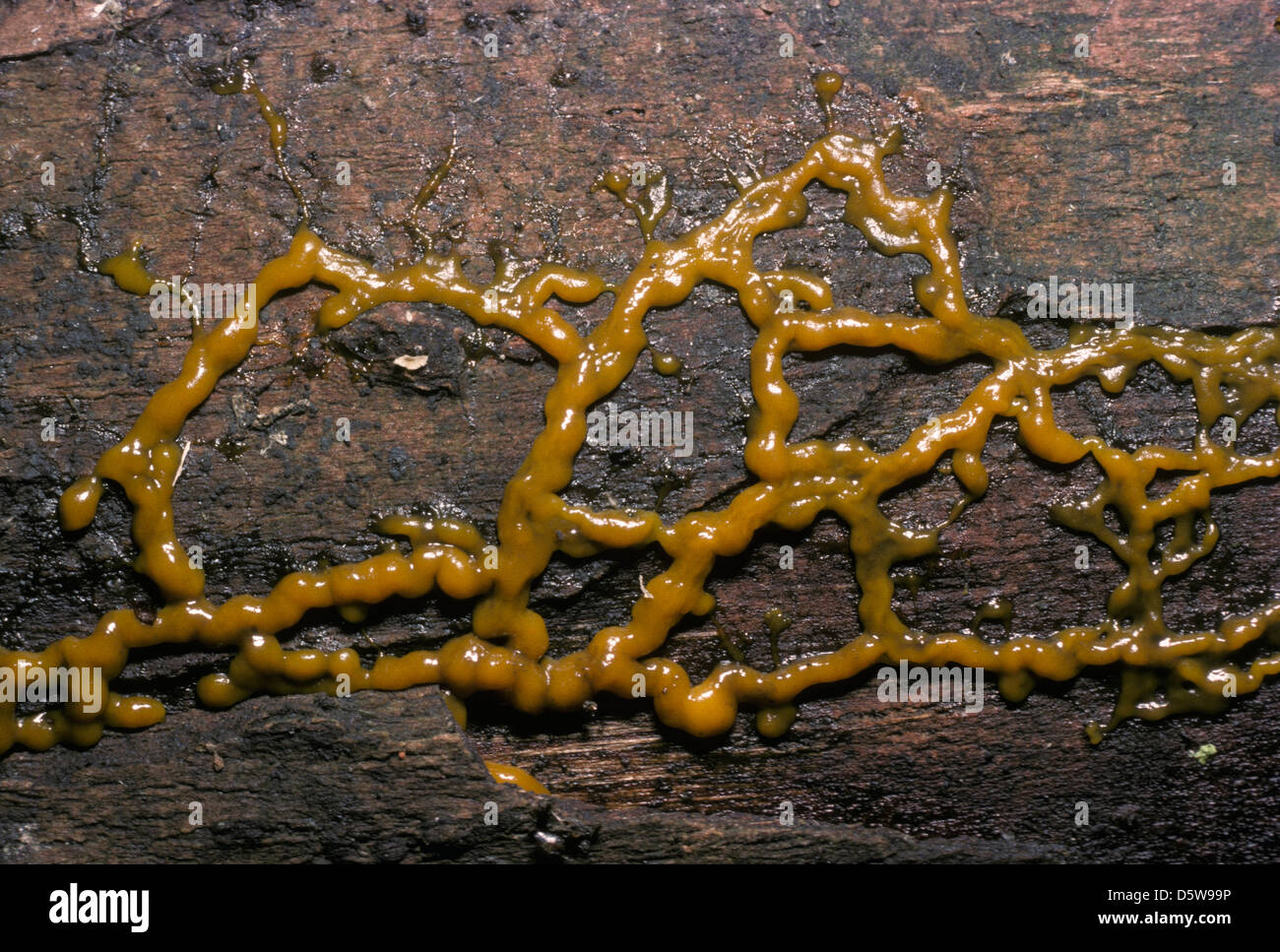 Badhamia sp. Myxomycete or slime mould plasmodium developing on a log, UK Stock Photohttps://www.alamy.com/image-license-details/?v=1https://www.alamy.com/stock-photo-badhamia-sp-myxomycete-or-slime-mould-plasmodium-developing-on-a-log-55260514.html
Badhamia sp. Myxomycete or slime mould plasmodium developing on a log, UK Stock Photohttps://www.alamy.com/image-license-details/?v=1https://www.alamy.com/stock-photo-badhamia-sp-myxomycete-or-slime-mould-plasmodium-developing-on-a-log-55260514.htmlRMD5W99P–Badhamia sp. Myxomycete or slime mould plasmodium developing on a log, UK
 . Plant studies; an elementary botany. Botany. THALLOPHYTES : FUNGI 291 In certain conditions, however, these slimy bodies come to rest and organize most elaborate and often very beau- tiful sporangia, full of spores (Fig. 267). These varied and easily preserved sporangia are used to classify the. Fig. 267. Three common slime moulds (Myxomycetes) on decaying wood : to the left above, groups of the sessile sporangia of Trichia ; to the right above, a group of the stalked sporangia of Stemonitis, with remnant of old Plasmodium at base ; below, groups uf sporangia of Hemiarcyria, with a Plasmodiu Stock Photohttps://www.alamy.com/image-license-details/?v=1https://www.alamy.com/plant-studies-an-elementary-botany-botany-thallophytes-fungi-291-in-certain-conditions-however-these-slimy-bodies-come-to-rest-and-organize-most-elaborate-and-often-very-beau-tiful-sporangia-full-of-spores-fig-267-these-varied-and-easily-preserved-sporangia-are-used-to-classify-the-fig-267-three-common-slime-moulds-myxomycetes-on-decaying-wood-to-the-left-above-groups-of-the-sessile-sporangia-of-trichia-to-the-right-above-a-group-of-the-stalked-sporangia-of-stemonitis-with-remnant-of-old-plasmodium-at-base-below-groups-uf-sporangia-of-hemiarcyria-with-a-plasmodiu-image232376425.html
. Plant studies; an elementary botany. Botany. THALLOPHYTES : FUNGI 291 In certain conditions, however, these slimy bodies come to rest and organize most elaborate and often very beau- tiful sporangia, full of spores (Fig. 267). These varied and easily preserved sporangia are used to classify the. Fig. 267. Three common slime moulds (Myxomycetes) on decaying wood : to the left above, groups of the sessile sporangia of Trichia ; to the right above, a group of the stalked sporangia of Stemonitis, with remnant of old Plasmodium at base ; below, groups uf sporangia of Hemiarcyria, with a Plasmodiu Stock Photohttps://www.alamy.com/image-license-details/?v=1https://www.alamy.com/plant-studies-an-elementary-botany-botany-thallophytes-fungi-291-in-certain-conditions-however-these-slimy-bodies-come-to-rest-and-organize-most-elaborate-and-often-very-beau-tiful-sporangia-full-of-spores-fig-267-these-varied-and-easily-preserved-sporangia-are-used-to-classify-the-fig-267-three-common-slime-moulds-myxomycetes-on-decaying-wood-to-the-left-above-groups-of-the-sessile-sporangia-of-trichia-to-the-right-above-a-group-of-the-stalked-sporangia-of-stemonitis-with-remnant-of-old-plasmodium-at-base-below-groups-uf-sporangia-of-hemiarcyria-with-a-plasmodiu-image232376425.htmlRMRE1JE1–. Plant studies; an elementary botany. Botany. THALLOPHYTES : FUNGI 291 In certain conditions, however, these slimy bodies come to rest and organize most elaborate and often very beau- tiful sporangia, full of spores (Fig. 267). These varied and easily preserved sporangia are used to classify the. Fig. 267. Three common slime moulds (Myxomycetes) on decaying wood : to the left above, groups of the sessile sporangia of Trichia ; to the right above, a group of the stalked sporangia of Stemonitis, with remnant of old Plasmodium at base ; below, groups uf sporangia of Hemiarcyria, with a Plasmodiu
 Group of a slime mold - Stemonitis fusca. It fruits in clusters on dead wood and has distinctive tall brown sporangia supported on slender stalks with Stock Photohttps://www.alamy.com/image-license-details/?v=1https://www.alamy.com/group-of-a-slime-mold-stemonitis-fusca-it-fruits-in-clusters-on-dead-wood-and-has-distinctive-tall-brown-sporangia-supported-on-slender-stalks-with-image622466587.html
Group of a slime mold - Stemonitis fusca. It fruits in clusters on dead wood and has distinctive tall brown sporangia supported on slender stalks with Stock Photohttps://www.alamy.com/image-license-details/?v=1https://www.alamy.com/group-of-a-slime-mold-stemonitis-fusca-it-fruits-in-clusters-on-dead-wood-and-has-distinctive-tall-brown-sporangia-supported-on-slender-stalks-with-image622466587.htmlRF2Y4KPDF–Group of a slime mold - Stemonitis fusca. It fruits in clusters on dead wood and has distinctive tall brown sporangia supported on slender stalks with
 Myxomycetes slime mold fruit fruiting body grassland nature natural wild wildlife environment environmental europe european Stock Photohttps://www.alamy.com/image-license-details/?v=1https://www.alamy.com/stock-photo-myxomycetes-slime-mold-fruit-fruiting-body-grassland-nature-natural-33118688.html
Myxomycetes slime mold fruit fruiting body grassland nature natural wild wildlife environment environmental europe european Stock Photohttps://www.alamy.com/image-license-details/?v=1https://www.alamy.com/stock-photo-myxomycetes-slime-mold-fruit-fruiting-body-grassland-nature-natural-33118688.htmlRMBWTK68–Myxomycetes slime mold fruit fruiting body grassland nature natural wild wildlife environment environmental europe european
 . The elements of botany embracing organography, histology, vegetable physiology, systematic botany and economic botany ... together with a complete glossary of botanical terms. Botany. PROTOPHYTA. 123 is presented by some of the members of this group, viz. by the formation of spores (Fig. 233). 156. As representatives of this division (Protophyta), the Myxomycetes, or Slime-Moulds, are the most re- markablck During their growing, or vegetative stage, they consist of a homogeneous mass of colored (but never green) protoplasm, which has received the name of plasmodium. There is no cell-wall; th Stock Photohttps://www.alamy.com/image-license-details/?v=1https://www.alamy.com/the-elements-of-botany-embracing-organography-histology-vegetable-physiology-systematic-botany-and-economic-botany-together-with-a-complete-glossary-of-botanical-terms-botany-protophyta-123-is-presented-by-some-of-the-members-of-this-group-viz-by-the-formation-of-spores-fig-233-156-as-representatives-of-this-division-protophyta-the-myxomycetes-or-slime-moulds-are-the-most-re-markablck-during-their-growing-or-vegetative-stage-they-consist-of-a-homogeneous-mass-of-colored-but-never-green-protoplasm-which-has-received-the-name-of-plasmodium-there-is-no-cell-wall-th-image216447301.html
. The elements of botany embracing organography, histology, vegetable physiology, systematic botany and economic botany ... together with a complete glossary of botanical terms. Botany. PROTOPHYTA. 123 is presented by some of the members of this group, viz. by the formation of spores (Fig. 233). 156. As representatives of this division (Protophyta), the Myxomycetes, or Slime-Moulds, are the most re- markablck During their growing, or vegetative stage, they consist of a homogeneous mass of colored (but never green) protoplasm, which has received the name of plasmodium. There is no cell-wall; th Stock Photohttps://www.alamy.com/image-license-details/?v=1https://www.alamy.com/the-elements-of-botany-embracing-organography-histology-vegetable-physiology-systematic-botany-and-economic-botany-together-with-a-complete-glossary-of-botanical-terms-botany-protophyta-123-is-presented-by-some-of-the-members-of-this-group-viz-by-the-formation-of-spores-fig-233-156-as-representatives-of-this-division-protophyta-the-myxomycetes-or-slime-moulds-are-the-most-re-markablck-during-their-growing-or-vegetative-stage-they-consist-of-a-homogeneous-mass-of-colored-but-never-green-protoplasm-which-has-received-the-name-of-plasmodium-there-is-no-cell-wall-th-image216447301.htmlRMPG40MN–. The elements of botany embracing organography, histology, vegetable physiology, systematic botany and economic botany ... together with a complete glossary of botanical terms. Botany. PROTOPHYTA. 123 is presented by some of the members of this group, viz. by the formation of spores (Fig. 233). 156. As representatives of this division (Protophyta), the Myxomycetes, or Slime-Moulds, are the most re- markablck During their growing, or vegetative stage, they consist of a homogeneous mass of colored (but never green) protoplasm, which has received the name of plasmodium. There is no cell-wall; th
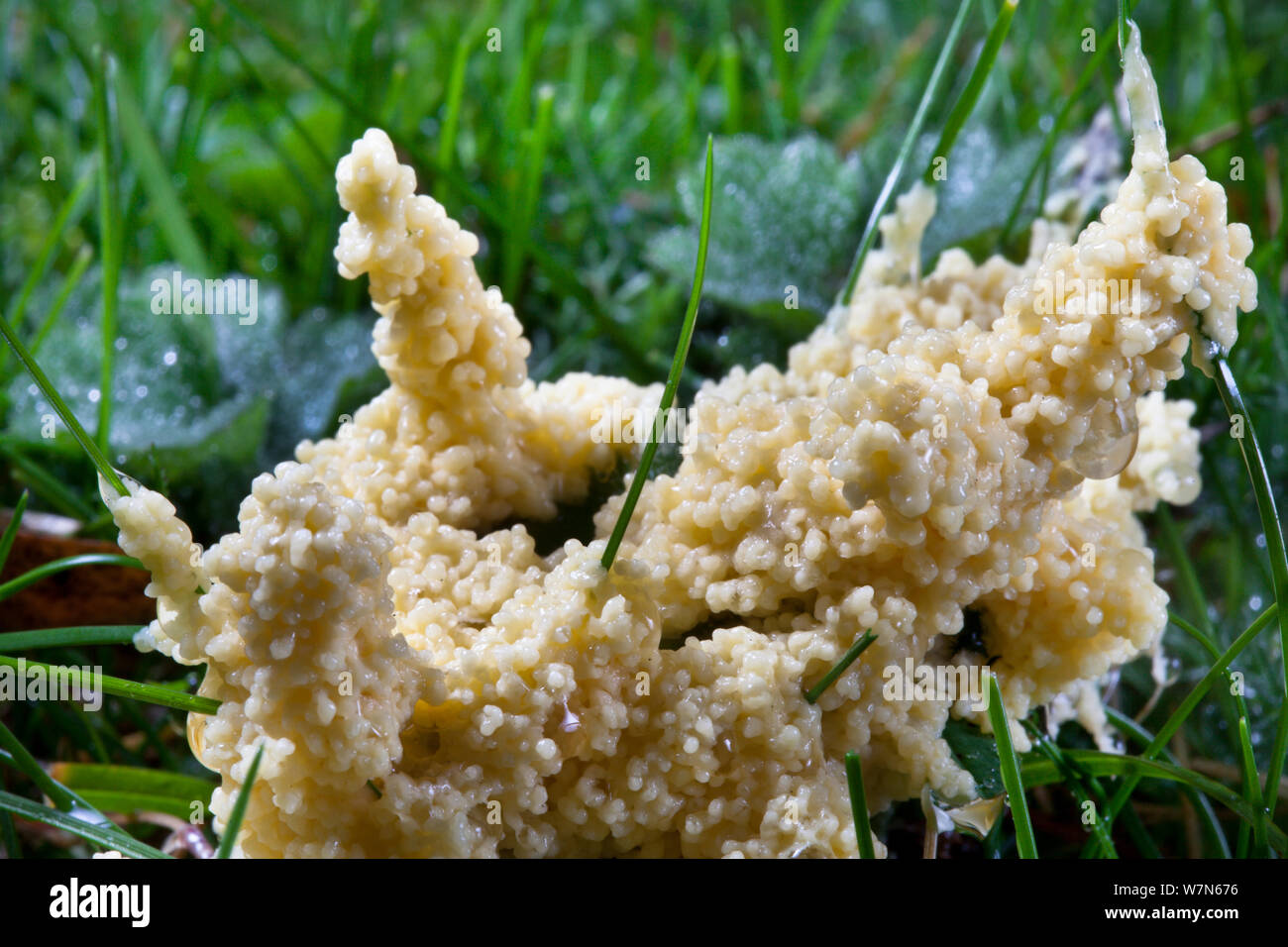 Slime Mould (Mucilago crustacea) at the plasmodium stage of its lifecycle, found in the corner of a field on wet grass. Peak District National Park, Derbyshire, UK, September. Stock Photohttps://www.alamy.com/image-license-details/?v=1https://www.alamy.com/slime-mould-mucilago-crustacea-at-the-plasmodium-stage-of-its-lifecycle-found-in-the-corner-of-a-field-on-wet-grass-peak-district-national-park-derbyshire-uk-september-image262924010.html
Slime Mould (Mucilago crustacea) at the plasmodium stage of its lifecycle, found in the corner of a field on wet grass. Peak District National Park, Derbyshire, UK, September. Stock Photohttps://www.alamy.com/image-license-details/?v=1https://www.alamy.com/slime-mould-mucilago-crustacea-at-the-plasmodium-stage-of-its-lifecycle-found-in-the-corner-of-a-field-on-wet-grass-peak-district-national-park-derbyshire-uk-september-image262924010.htmlRMW7N676–Slime Mould (Mucilago crustacea) at the plasmodium stage of its lifecycle, found in the corner of a field on wet grass. Peak District National Park, Derbyshire, UK, September.
 Young slime mold (Arcyria sp.) fruiting bodies (sporangia) grow on a rotting tree. Stock Photohttps://www.alamy.com/image-license-details/?v=1https://www.alamy.com/young-slime-mold-arcyria-sp-fruiting-bodies-sporangia-grow-on-a-rotting-tree-image258959099.html
Young slime mold (Arcyria sp.) fruiting bodies (sporangia) grow on a rotting tree. Stock Photohttps://www.alamy.com/image-license-details/?v=1https://www.alamy.com/young-slime-mold-arcyria-sp-fruiting-bodies-sporangia-grow-on-a-rotting-tree-image258959099.htmlRMW18GY7–Young slime mold (Arcyria sp.) fruiting bodies (sporangia) grow on a rotting tree.
 scrambled egg slime, flowers of tan (Fuligo septica), on moss, Bavaria, Oberbayern, Upper Bavaria, Alpenvorland Stock Photohttps://www.alamy.com/image-license-details/?v=1https://www.alamy.com/stock-photo-scrambled-egg-slime-flowers-of-tan-fuligo-septica-on-moss-bavaria-97244742.html
scrambled egg slime, flowers of tan (Fuligo septica), on moss, Bavaria, Oberbayern, Upper Bavaria, Alpenvorland Stock Photohttps://www.alamy.com/image-license-details/?v=1https://www.alamy.com/stock-photo-scrambled-egg-slime-flowers-of-tan-fuligo-septica-on-moss-bavaria-97244742.htmlRMFJ5TJE–scrambled egg slime, flowers of tan (Fuligo septica), on moss, Bavaria, Oberbayern, Upper Bavaria, Alpenvorland
 Wolf's Milk Slime (Lycogala epidendrum) globular fruiting bodies grow on a rotting tree. Stock Photohttps://www.alamy.com/image-license-details/?v=1https://www.alamy.com/wolfs-milk-slime-lycogala-epidendrum-globular-fruiting-bodies-grow-on-a-rotting-tree-image215557137.html
Wolf's Milk Slime (Lycogala epidendrum) globular fruiting bodies grow on a rotting tree. Stock Photohttps://www.alamy.com/image-license-details/?v=1https://www.alamy.com/wolfs-milk-slime-lycogala-epidendrum-globular-fruiting-bodies-grow-on-a-rotting-tree-image215557137.htmlRMPEKD95–Wolf's Milk Slime (Lycogala epidendrum) globular fruiting bodies grow on a rotting tree.
 Scrambled egg slime, Flowers of tan (Fuligo septica), on bark, Germany, Mecklenburg-Western Pomerania Stock Photohttps://www.alamy.com/image-license-details/?v=1https://www.alamy.com/stock-photo-scrambled-egg-slime-flowers-of-tan-fuligo-septica-on-bark-germany-97238165.html
Scrambled egg slime, Flowers of tan (Fuligo septica), on bark, Germany, Mecklenburg-Western Pomerania Stock Photohttps://www.alamy.com/image-license-details/?v=1https://www.alamy.com/stock-photo-scrambled-egg-slime-flowers-of-tan-fuligo-septica-on-bark-germany-97238165.htmlRMFJ5G7H–Scrambled egg slime, Flowers of tan (Fuligo septica), on bark, Germany, Mecklenburg-Western Pomerania
 Slime mold (Trichia sp.) fruiting bodies (sporangia) grow on a rotting tree. Stock Photohttps://www.alamy.com/image-license-details/?v=1https://www.alamy.com/slime-mold-trichia-sp-fruiting-bodies-sporangia-grow-on-a-rotting-tree-image215658389.html
Slime mold (Trichia sp.) fruiting bodies (sporangia) grow on a rotting tree. Stock Photohttps://www.alamy.com/image-license-details/?v=1https://www.alamy.com/slime-mold-trichia-sp-fruiting-bodies-sporangia-grow-on-a-rotting-tree-image215658389.htmlRMPET2D9–Slime mold (Trichia sp.) fruiting bodies (sporangia) grow on a rotting tree.
 Scrambled egg slime, Flowers of tan (Fuligo septica), on moss, Germany, Bavaria, Oberbayern, Upper Bavaria Stock Photohttps://www.alamy.com/image-license-details/?v=1https://www.alamy.com/stock-photo-scrambled-egg-slime-flowers-of-tan-fuligo-septica-on-moss-germany-97239655.html
Scrambled egg slime, Flowers of tan (Fuligo septica), on moss, Germany, Bavaria, Oberbayern, Upper Bavaria Stock Photohttps://www.alamy.com/image-license-details/?v=1https://www.alamy.com/stock-photo-scrambled-egg-slime-flowers-of-tan-fuligo-septica-on-moss-germany-97239655.htmlRMFJ5J4R–Scrambled egg slime, Flowers of tan (Fuligo septica), on moss, Germany, Bavaria, Oberbayern, Upper Bavaria
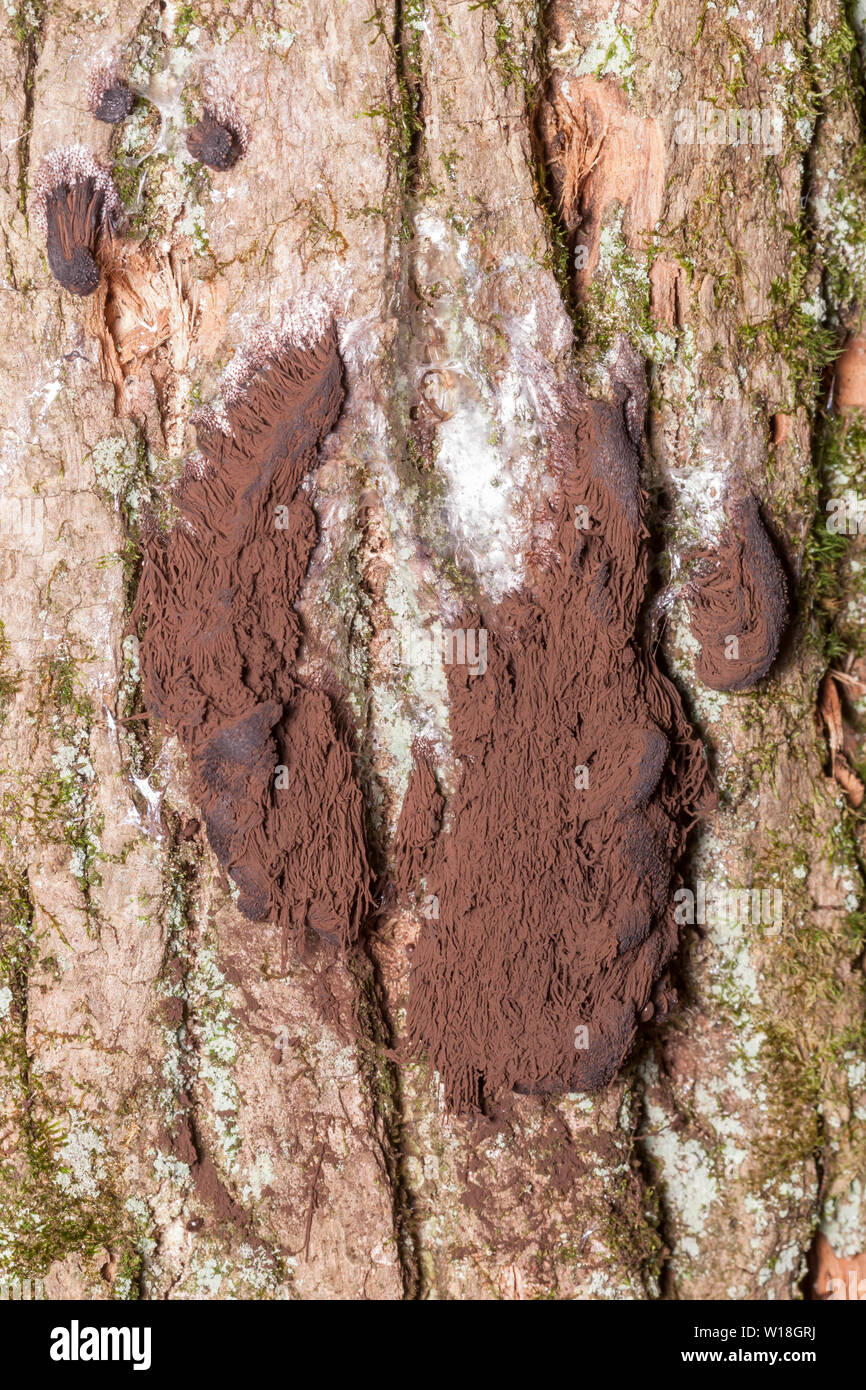 A large mass of Chocolate Tube Slime Mold (Stemonaria longa) on the side of a tree. The mass is approximately 150mm high. Stock Photohttps://www.alamy.com/image-license-details/?v=1https://www.alamy.com/a-large-mass-of-chocolate-tube-slime-mold-stemonaria-longa-on-the-side-of-a-tree-the-mass-is-approximately-150mm-high-image258958998.html
A large mass of Chocolate Tube Slime Mold (Stemonaria longa) on the side of a tree. The mass is approximately 150mm high. Stock Photohttps://www.alamy.com/image-license-details/?v=1https://www.alamy.com/a-large-mass-of-chocolate-tube-slime-mold-stemonaria-longa-on-the-side-of-a-tree-the-mass-is-approximately-150mm-high-image258958998.htmlRMW18GRJ–A large mass of Chocolate Tube Slime Mold (Stemonaria longa) on the side of a tree. The mass is approximately 150mm high.
 Wolf's milk, Groening's slime (Lycogala epidendrum, Lycogala epidendron), on dead wood, Germany, North Rhine-Westphalia Stock Photohttps://www.alamy.com/image-license-details/?v=1https://www.alamy.com/stock-photo-wolfs-milk-groenings-slime-lycogala-epidendrum-lycogala-epidendron-76078503.html
Wolf's milk, Groening's slime (Lycogala epidendrum, Lycogala epidendron), on dead wood, Germany, North Rhine-Westphalia Stock Photohttps://www.alamy.com/image-license-details/?v=1https://www.alamy.com/stock-photo-wolfs-milk-groenings-slime-lycogala-epidendrum-lycogala-epidendron-76078503.htmlRMEBNJWB–Wolf's milk, Groening's slime (Lycogala epidendrum, Lycogala epidendron), on dead wood, Germany, North Rhine-Westphalia
 Chocolate Tube Slime Mold (Stemonitis sp.) brown fruiting bodies (sporangia) growing on a rotting log. Stock Photohttps://www.alamy.com/image-license-details/?v=1https://www.alamy.com/chocolate-tube-slime-mold-stemonitis-sp-brown-fruiting-bodies-sporangia-growing-on-a-rotting-log-image215658388.html
Chocolate Tube Slime Mold (Stemonitis sp.) brown fruiting bodies (sporangia) growing on a rotting log. Stock Photohttps://www.alamy.com/image-license-details/?v=1https://www.alamy.com/chocolate-tube-slime-mold-stemonitis-sp-brown-fruiting-bodies-sporangia-growing-on-a-rotting-log-image215658388.htmlRMPET2D8–Chocolate Tube Slime Mold (Stemonitis sp.) brown fruiting bodies (sporangia) growing on a rotting log.
 Sulphur Slime Fungus (Fuligo septica), Slime Fungus on deadwood, Germany Stock Photohttps://www.alamy.com/image-license-details/?v=1https://www.alamy.com/stock-photo-sulphur-slime-fungus-fuligo-septica-slime-fungus-on-deadwood-germany-86055144.html
Sulphur Slime Fungus (Fuligo septica), Slime Fungus on deadwood, Germany Stock Photohttps://www.alamy.com/image-license-details/?v=1https://www.alamy.com/stock-photo-sulphur-slime-fungus-fuligo-septica-slime-fungus-on-deadwood-germany-86055144.htmlRMF00460–Sulphur Slime Fungus (Fuligo septica), Slime Fungus on deadwood, Germany
 Stemonitis fusca, known as tube slime mold Stock Photohttps://www.alamy.com/image-license-details/?v=1https://www.alamy.com/stemonitis-fusca-known-as-tube-slime-mold-image330919570.html
Stemonitis fusca, known as tube slime mold Stock Photohttps://www.alamy.com/image-license-details/?v=1https://www.alamy.com/stemonitis-fusca-known-as-tube-slime-mold-image330919570.htmlRF2A6AK82–Stemonitis fusca, known as tube slime mold
 Dog Sick Slime Mould - Mucilago crustacea Taken at Snipe Dales Nature Reserve, Lincolnshire, UK Stock Photohttps://www.alamy.com/image-license-details/?v=1https://www.alamy.com/stock-photo-dog-sick-slime-mould-mucilago-crustacea-taken-at-snipe-dales-nature-32052304.html
Dog Sick Slime Mould - Mucilago crustacea Taken at Snipe Dales Nature Reserve, Lincolnshire, UK Stock Photohttps://www.alamy.com/image-license-details/?v=1https://www.alamy.com/stock-photo-dog-sick-slime-mould-mucilago-crustacea-taken-at-snipe-dales-nature-32052304.htmlRMBT4314–Dog Sick Slime Mould - Mucilago crustacea Taken at Snipe Dales Nature Reserve, Lincolnshire, UK
 Dog Vomit Slime Mold Fuligo septica Stock Photohttps://www.alamy.com/image-license-details/?v=1https://www.alamy.com/stock-photo-dog-vomit-slime-mold-fuligo-septica-48955783.html
Dog Vomit Slime Mold Fuligo septica Stock Photohttps://www.alamy.com/image-license-details/?v=1https://www.alamy.com/stock-photo-dog-vomit-slime-mold-fuligo-septica-48955783.htmlRMCRJ3GR–Dog Vomit Slime Mold Fuligo septica
 . Plants; a text-book of botany. Botany. THALL0PHYTE8 : FUNGI 75 In certain conditions, however, these slimy bodies come to rest and organize most elaborate and often very beau- tiful sporangia, full of spores (Fig. 67). These varied and easily preserved sporangia are used to classify the. Fig. 67. Three common slime moulds (Myxomycetes) on decaying wood; to the left above, groups of the sessile sporangia of Tricaia ,' to the right above, a group of the stalked sporangia of Siemoniiis, with remnant of old Plasmodium at base; below, groups of sporangia of Hemiarcyria^ w^ith a Plasmodium mass at Stock Photohttps://www.alamy.com/image-license-details/?v=1https://www.alamy.com/plants-a-text-book-of-botany-botany-thall0phyte8-fungi-75-in-certain-conditions-however-these-slimy-bodies-come-to-rest-and-organize-most-elaborate-and-often-very-beau-tiful-sporangia-full-of-spores-fig-67-these-varied-and-easily-preserved-sporangia-are-used-to-classify-the-fig-67-three-common-slime-moulds-myxomycetes-on-decaying-wood-to-the-left-above-groups-of-the-sessile-sporangia-of-tricaia-to-the-right-above-a-group-of-the-stalked-sporangia-of-siemoniiis-with-remnant-of-old-plasmodium-at-base-below-groups-of-sporangia-of-hemiarcyria-with-a-plasmodium-mass-at-image232282665.html
. Plants; a text-book of botany. Botany. THALL0PHYTE8 : FUNGI 75 In certain conditions, however, these slimy bodies come to rest and organize most elaborate and often very beau- tiful sporangia, full of spores (Fig. 67). These varied and easily preserved sporangia are used to classify the. Fig. 67. Three common slime moulds (Myxomycetes) on decaying wood; to the left above, groups of the sessile sporangia of Tricaia ,' to the right above, a group of the stalked sporangia of Siemoniiis, with remnant of old Plasmodium at base; below, groups of sporangia of Hemiarcyria^ w^ith a Plasmodium mass at Stock Photohttps://www.alamy.com/image-license-details/?v=1https://www.alamy.com/plants-a-text-book-of-botany-botany-thall0phyte8-fungi-75-in-certain-conditions-however-these-slimy-bodies-come-to-rest-and-organize-most-elaborate-and-often-very-beau-tiful-sporangia-full-of-spores-fig-67-these-varied-and-easily-preserved-sporangia-are-used-to-classify-the-fig-67-three-common-slime-moulds-myxomycetes-on-decaying-wood-to-the-left-above-groups-of-the-sessile-sporangia-of-tricaia-to-the-right-above-a-group-of-the-stalked-sporangia-of-siemoniiis-with-remnant-of-old-plasmodium-at-base-below-groups-of-sporangia-of-hemiarcyria-with-a-plasmodium-mass-at-image232282665.htmlRMRDWAWD–. Plants; a text-book of botany. Botany. THALL0PHYTE8 : FUNGI 75 In certain conditions, however, these slimy bodies come to rest and organize most elaborate and often very beau- tiful sporangia, full of spores (Fig. 67). These varied and easily preserved sporangia are used to classify the. Fig. 67. Three common slime moulds (Myxomycetes) on decaying wood; to the left above, groups of the sessile sporangia of Tricaia ,' to the right above, a group of the stalked sporangia of Siemoniiis, with remnant of old Plasmodium at base; below, groups of sporangia of Hemiarcyria^ w^ith a Plasmodium mass at
 Slime Mould Enteridium lycoperdon Taken at Dibbinsdale LNR, Wirral, UK Stock Photohttps://www.alamy.com/image-license-details/?v=1https://www.alamy.com/stock-photo-slime-mould-enteridium-lycoperdon-taken-at-dibbinsdale-lnr-wirral-31613560.html
Slime Mould Enteridium lycoperdon Taken at Dibbinsdale LNR, Wirral, UK Stock Photohttps://www.alamy.com/image-license-details/?v=1https://www.alamy.com/stock-photo-slime-mould-enteridium-lycoperdon-taken-at-dibbinsdale-lnr-wirral-31613560.htmlRMBRC3BM–Slime Mould Enteridium lycoperdon Taken at Dibbinsdale LNR, Wirral, UK
 Group of a slime mold - Stemonitis fusca. It fruits in clusters on dead wood and has distinctive tall brown sporangia supported on slender stalks with Stock Photohttps://www.alamy.com/image-license-details/?v=1https://www.alamy.com/group-of-a-slime-mold-stemonitis-fusca-it-fruits-in-clusters-on-dead-wood-and-has-distinctive-tall-brown-sporangia-supported-on-slender-stalks-with-image622191063.html
Group of a slime mold - Stemonitis fusca. It fruits in clusters on dead wood and has distinctive tall brown sporangia supported on slender stalks with Stock Photohttps://www.alamy.com/image-license-details/?v=1https://www.alamy.com/group-of-a-slime-mold-stemonitis-fusca-it-fruits-in-clusters-on-dead-wood-and-has-distinctive-tall-brown-sporangia-supported-on-slender-stalks-with-image622191063.htmlRF2Y4771B–Group of a slime mold - Stemonitis fusca. It fruits in clusters on dead wood and has distinctive tall brown sporangia supported on slender stalks with
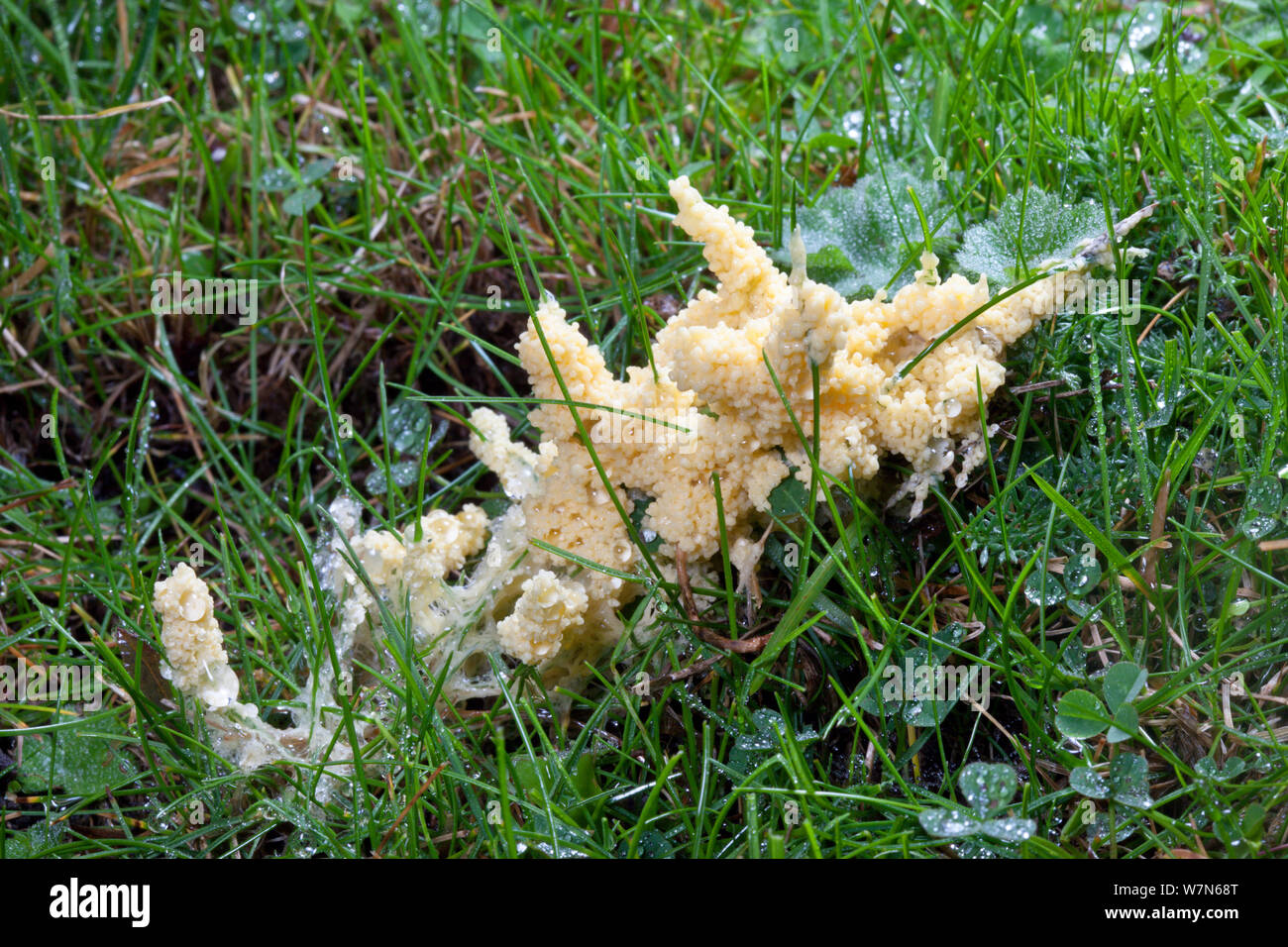 Slime Mould (Mucilago crustacea) at the plasmodium stage of its lifecycle, found in the corner of a field on wet grass. Peak District National Park, Derbyshire, UK, September. Stock Photohttps://www.alamy.com/image-license-details/?v=1https://www.alamy.com/slime-mould-mucilago-crustacea-at-the-plasmodium-stage-of-its-lifecycle-found-in-the-corner-of-a-field-on-wet-grass-peak-district-national-park-derbyshire-uk-september-image262924056.html
Slime Mould (Mucilago crustacea) at the plasmodium stage of its lifecycle, found in the corner of a field on wet grass. Peak District National Park, Derbyshire, UK, September. Stock Photohttps://www.alamy.com/image-license-details/?v=1https://www.alamy.com/slime-mould-mucilago-crustacea-at-the-plasmodium-stage-of-its-lifecycle-found-in-the-corner-of-a-field-on-wet-grass-peak-district-national-park-derbyshire-uk-september-image262924056.htmlRMW7N68T–Slime Mould (Mucilago crustacea) at the plasmodium stage of its lifecycle, found in the corner of a field on wet grass. Peak District National Park, Derbyshire, UK, September.
 Wolf's-milk Slime-mould (Lycogala epidendrum) protoplasm, forming aethalia fruiting bodies, growing over rotting wood, Powys, Stock Photohttps://www.alamy.com/image-license-details/?v=1https://www.alamy.com/stock-photo-wolfs-milk-slime-mould-lycogala-epidendrum-protoplasm-forming-aethalia-33118676.html
Wolf's-milk Slime-mould (Lycogala epidendrum) protoplasm, forming aethalia fruiting bodies, growing over rotting wood, Powys, Stock Photohttps://www.alamy.com/image-license-details/?v=1https://www.alamy.com/stock-photo-wolfs-milk-slime-mould-lycogala-epidendrum-protoplasm-forming-aethalia-33118676.htmlRMBWTK5T–Wolf's-milk Slime-mould (Lycogala epidendrum) protoplasm, forming aethalia fruiting bodies, growing over rotting wood, Powys,
 Dog Vomit / Scrambled Egg Slime Mould (Fuligo septica var. septica), a species of plasmodial slime mould (Myxomycetes class). Found on deciduous woodland floor. Peak District National Park, Derbyshire, UK. October. Stock Photohttps://www.alamy.com/image-license-details/?v=1https://www.alamy.com/dog-vomit-scrambled-egg-slime-mould-fuligo-septica-var-septica-a-species-of-plasmodial-slime-mould-myxomycetes-class-found-on-deciduous-woodland-floor-peak-district-national-park-derbyshire-uk-october-image262941642.html
Dog Vomit / Scrambled Egg Slime Mould (Fuligo septica var. septica), a species of plasmodial slime mould (Myxomycetes class). Found on deciduous woodland floor. Peak District National Park, Derbyshire, UK. October. Stock Photohttps://www.alamy.com/image-license-details/?v=1https://www.alamy.com/dog-vomit-scrambled-egg-slime-mould-fuligo-septica-var-septica-a-species-of-plasmodial-slime-mould-myxomycetes-class-found-on-deciduous-woodland-floor-peak-district-national-park-derbyshire-uk-october-image262941642.htmlRMW7P0MX–Dog Vomit / Scrambled Egg Slime Mould (Fuligo septica var. septica), a species of plasmodial slime mould (Myxomycetes class). Found on deciduous woodland floor. Peak District National Park, Derbyshire, UK. October.
 . Zoology : for students and general readers . Zoology. Dt8TWCTtOKS BETWEEN ANIMALS AND PLANTS. 3 organisms is inorganic particles. The slime-moulds called Myxomycetes, however, envelop the plant or low animals, much as an Amoeha throws itself around some living plant and absorbs its protoplasm ; but Mijxoimjcctes, in their man- ner of taking food, are an exception to other moulds. The lowest animals swallow other living animals whole or in pieces ; certain forms like Amosba (Fig. 3) bore into minute algffl and absorb their pro- toplasm ; others engulf sili- cious-shelled plants (diatoms and d Stock Photohttps://www.alamy.com/image-license-details/?v=1https://www.alamy.com/zoology-for-students-and-general-readers-zoology-dt8twcttoks-between-animals-and-plants-3-organisms-is-inorganic-particles-the-slime-moulds-called-myxomycetes-however-envelop-the-plant-or-low-animals-much-as-an-amoeha-throws-itself-around-some-living-plant-and-absorbs-its-protoplasm-but-mijxoimjcctes-in-their-man-ner-of-taking-food-are-an-exception-to-other-moulds-the-lowest-animals-swallow-other-living-animals-whole-or-in-pieces-certain-forms-like-amosba-fig-3-bore-into-minute-algffl-and-absorb-their-pro-toplasm-others-engulf-sili-cious-shelled-plants-diatoms-and-d-image216404848.html
. Zoology : for students and general readers . Zoology. Dt8TWCTtOKS BETWEEN ANIMALS AND PLANTS. 3 organisms is inorganic particles. The slime-moulds called Myxomycetes, however, envelop the plant or low animals, much as an Amoeha throws itself around some living plant and absorbs its protoplasm ; but Mijxoimjcctes, in their man- ner of taking food, are an exception to other moulds. The lowest animals swallow other living animals whole or in pieces ; certain forms like Amosba (Fig. 3) bore into minute algffl and absorb their pro- toplasm ; others engulf sili- cious-shelled plants (diatoms and d Stock Photohttps://www.alamy.com/image-license-details/?v=1https://www.alamy.com/zoology-for-students-and-general-readers-zoology-dt8twcttoks-between-animals-and-plants-3-organisms-is-inorganic-particles-the-slime-moulds-called-myxomycetes-however-envelop-the-plant-or-low-animals-much-as-an-amoeha-throws-itself-around-some-living-plant-and-absorbs-its-protoplasm-but-mijxoimjcctes-in-their-man-ner-of-taking-food-are-an-exception-to-other-moulds-the-lowest-animals-swallow-other-living-animals-whole-or-in-pieces-certain-forms-like-amosba-fig-3-bore-into-minute-algffl-and-absorb-their-pro-toplasm-others-engulf-sili-cious-shelled-plants-diatoms-and-d-image216404848.htmlRMPG22GG–. Zoology : for students and general readers . Zoology. Dt8TWCTtOKS BETWEEN ANIMALS AND PLANTS. 3 organisms is inorganic particles. The slime-moulds called Myxomycetes, however, envelop the plant or low animals, much as an Amoeha throws itself around some living plant and absorbs its protoplasm ; but Mijxoimjcctes, in their man- ner of taking food, are an exception to other moulds. The lowest animals swallow other living animals whole or in pieces ; certain forms like Amosba (Fig. 3) bore into minute algffl and absorb their pro- toplasm ; others engulf sili- cious-shelled plants (diatoms and d
 Chocolate Tube Slime Mold (Stemonitis sp.) brown fruiting bodies (sporangia) growing on a rotting log. Stock Photohttps://www.alamy.com/image-license-details/?v=1https://www.alamy.com/chocolate-tube-slime-mold-stemonitis-sp-brown-fruiting-bodies-sporangia-growing-on-a-rotting-log-image215658387.html
Chocolate Tube Slime Mold (Stemonitis sp.) brown fruiting bodies (sporangia) growing on a rotting log. Stock Photohttps://www.alamy.com/image-license-details/?v=1https://www.alamy.com/chocolate-tube-slime-mold-stemonitis-sp-brown-fruiting-bodies-sporangia-growing-on-a-rotting-log-image215658387.htmlRMPET2D7–Chocolate Tube Slime Mold (Stemonitis sp.) brown fruiting bodies (sporangia) growing on a rotting log.
 Sulphur Slime Fungus (Fuligo septica), Slime Fungus on deadwood, Germany Stock Photohttps://www.alamy.com/image-license-details/?v=1https://www.alamy.com/stock-photo-sulphur-slime-fungus-fuligo-septica-slime-fungus-on-deadwood-germany-86055142.html
Sulphur Slime Fungus (Fuligo septica), Slime Fungus on deadwood, Germany Stock Photohttps://www.alamy.com/image-license-details/?v=1https://www.alamy.com/stock-photo-sulphur-slime-fungus-fuligo-septica-slime-fungus-on-deadwood-germany-86055142.htmlRMF0045X–Sulphur Slime Fungus (Fuligo septica), Slime Fungus on deadwood, Germany
 Chocolate Tube Slime Mold (Stemonitis sp.) brown fruiting bodies (sporangia) grow on a rotting log. Stock Photohttps://www.alamy.com/image-license-details/?v=1https://www.alamy.com/chocolate-tube-slime-mold-stemonitis-sp-brown-fruiting-bodies-sporangia-grow-on-a-rotting-log-image215557141.html
Chocolate Tube Slime Mold (Stemonitis sp.) brown fruiting bodies (sporangia) grow on a rotting log. Stock Photohttps://www.alamy.com/image-license-details/?v=1https://www.alamy.com/chocolate-tube-slime-mold-stemonitis-sp-brown-fruiting-bodies-sporangia-grow-on-a-rotting-log-image215557141.htmlRMPEKD99–Chocolate Tube Slime Mold (Stemonitis sp.) brown fruiting bodies (sporangia) grow on a rotting log.
 slime fungus (Myxogastria spec.), on dead wood, Netherlands Stock Photohttps://www.alamy.com/image-license-details/?v=1https://www.alamy.com/slime-fungus-myxogastria-spec-on-dead-wood-netherlands-image255382552.html
slime fungus (Myxogastria spec.), on dead wood, Netherlands Stock Photohttps://www.alamy.com/image-license-details/?v=1https://www.alamy.com/slime-fungus-myxogastria-spec-on-dead-wood-netherlands-image255382552.htmlRMTRDK1C–slime fungus (Myxogastria spec.), on dead wood, Netherlands
 Stalked fruiting bodies of Multigoblet Slime Mold (Metatrichia vesparium) grow on the side of a rotting dead tree. Stock Photohttps://www.alamy.com/image-license-details/?v=1https://www.alamy.com/stalked-fruiting-bodies-of-multigoblet-slime-mold-metatrichia-vesparium-grow-on-the-side-of-a-rotting-dead-tree-image215251037.html
Stalked fruiting bodies of Multigoblet Slime Mold (Metatrichia vesparium) grow on the side of a rotting dead tree. Stock Photohttps://www.alamy.com/image-license-details/?v=1https://www.alamy.com/stalked-fruiting-bodies-of-multigoblet-slime-mold-metatrichia-vesparium-grow-on-the-side-of-a-rotting-dead-tree-image215251037.htmlRMPE5EW1–Stalked fruiting bodies of Multigoblet Slime Mold (Metatrichia vesparium) grow on the side of a rotting dead tree.
 Stemonitis fusca, known as tube slime mold Stock Photohttps://www.alamy.com/image-license-details/?v=1https://www.alamy.com/stemonitis-fusca-known-as-tube-slime-mold-image331516751.html
Stemonitis fusca, known as tube slime mold Stock Photohttps://www.alamy.com/image-license-details/?v=1https://www.alamy.com/stemonitis-fusca-known-as-tube-slime-mold-image331516751.htmlRF2A79TYY–Stemonitis fusca, known as tube slime mold
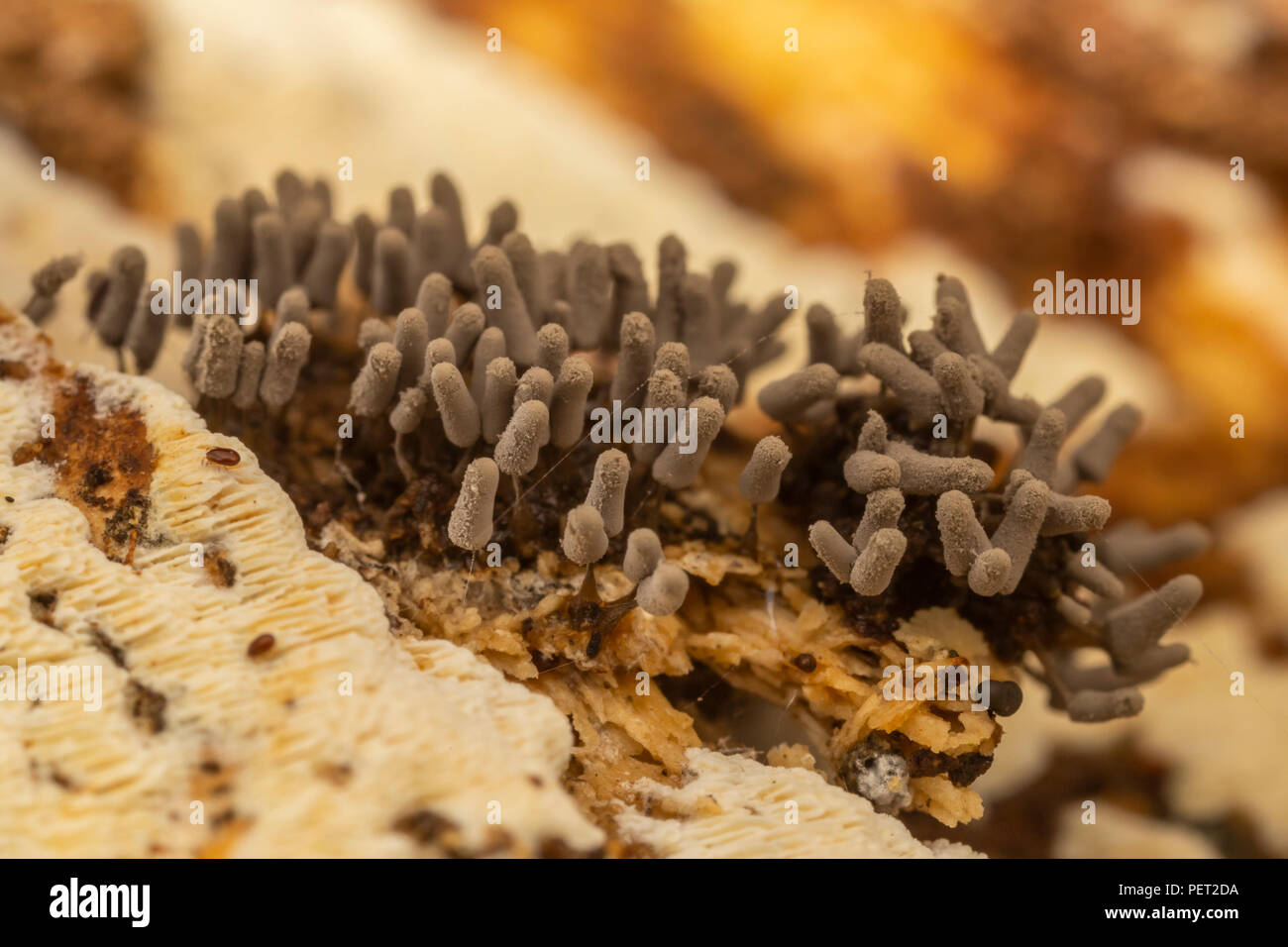 Slime mold (Arcyria cinerea) fruiting bodies (sporangia) grow on a rotting tree. Stock Photohttps://www.alamy.com/image-license-details/?v=1https://www.alamy.com/slime-mold-arcyria-cinerea-fruiting-bodies-sporangia-grow-on-a-rotting-tree-image215658390.html
Slime mold (Arcyria cinerea) fruiting bodies (sporangia) grow on a rotting tree. Stock Photohttps://www.alamy.com/image-license-details/?v=1https://www.alamy.com/slime-mold-arcyria-cinerea-fruiting-bodies-sporangia-grow-on-a-rotting-tree-image215658390.htmlRMPET2DA–Slime mold (Arcyria cinerea) fruiting bodies (sporangia) grow on a rotting tree.
 . The essentials of botany. Botany. 106 BOTANY. Class I. Slime-Moulds {Myxomycetes). 218. The Slime-moulds are in many respects the most remarkable of all known plants. They fiear so strong a resemblance to the lowest animals (Protozoa) that they have been, time and again, placed in the animal kingdom. Fio. 44.—A p«,rt of a Slime-mould (Physarum leucopus) in its vegetative stage. Magnified 350 times. by various naturalists. When we compare them with any other plants, they are found to differ from them so widely that very little relationship can be detected. 219. A Slime-mould is a mass of nake Stock Photohttps://www.alamy.com/image-license-details/?v=1https://www.alamy.com/the-essentials-of-botany-botany-106-botany-class-i-slime-moulds-myxomycetes-218-the-slime-moulds-are-in-many-respects-the-most-remarkable-of-all-known-plants-they-fiear-so-strong-a-resemblance-to-the-lowest-animals-protozoa-that-they-have-been-time-and-again-placed-in-the-animal-kingdom-fio-44a-prt-of-a-slime-mould-physarum-leucopus-in-its-vegetative-stage-magnified-350-times-by-various-naturalists-when-we-compare-them-with-any-other-plants-they-are-found-to-differ-from-them-so-widely-that-very-little-relationship-can-be-detected-219-a-slime-mould-is-a-mass-of-nake-image232283621.html
. The essentials of botany. Botany. 106 BOTANY. Class I. Slime-Moulds {Myxomycetes). 218. The Slime-moulds are in many respects the most remarkable of all known plants. They fiear so strong a resemblance to the lowest animals (Protozoa) that they have been, time and again, placed in the animal kingdom. Fio. 44.—A p«,rt of a Slime-mould (Physarum leucopus) in its vegetative stage. Magnified 350 times. by various naturalists. When we compare them with any other plants, they are found to differ from them so widely that very little relationship can be detected. 219. A Slime-mould is a mass of nake Stock Photohttps://www.alamy.com/image-license-details/?v=1https://www.alamy.com/the-essentials-of-botany-botany-106-botany-class-i-slime-moulds-myxomycetes-218-the-slime-moulds-are-in-many-respects-the-most-remarkable-of-all-known-plants-they-fiear-so-strong-a-resemblance-to-the-lowest-animals-protozoa-that-they-have-been-time-and-again-placed-in-the-animal-kingdom-fio-44a-prt-of-a-slime-mould-physarum-leucopus-in-its-vegetative-stage-magnified-350-times-by-various-naturalists-when-we-compare-them-with-any-other-plants-they-are-found-to-differ-from-them-so-widely-that-very-little-relationship-can-be-detected-219-a-slime-mould-is-a-mass-of-nake-image232283621.htmlRMRDWC3H–. The essentials of botany. Botany. 106 BOTANY. Class I. Slime-Moulds {Myxomycetes). 218. The Slime-moulds are in many respects the most remarkable of all known plants. They fiear so strong a resemblance to the lowest animals (Protozoa) that they have been, time and again, placed in the animal kingdom. Fio. 44.—A p«,rt of a Slime-mould (Physarum leucopus) in its vegetative stage. Magnified 350 times. by various naturalists. When we compare them with any other plants, they are found to differ from them so widely that very little relationship can be detected. 219. A Slime-mould is a mass of nake
 Carnival Candy Slime Mold (Arcyria denudata) fruiting bodies (sporangia) grow on a rotting tree. Stock Photohttps://www.alamy.com/image-license-details/?v=1https://www.alamy.com/carnival-candy-slime-mold-arcyria-denudata-fruiting-bodies-sporangia-grow-on-a-rotting-tree-image215557140.html
Carnival Candy Slime Mold (Arcyria denudata) fruiting bodies (sporangia) grow on a rotting tree. Stock Photohttps://www.alamy.com/image-license-details/?v=1https://www.alamy.com/carnival-candy-slime-mold-arcyria-denudata-fruiting-bodies-sporangia-grow-on-a-rotting-tree-image215557140.htmlRMPEKD98–Carnival Candy Slime Mold (Arcyria denudata) fruiting bodies (sporangia) grow on a rotting tree.
 Group of a slime mold - Stemonitis fusca. It fruits in clusters on dead wood and has distinctive tall brown sporangia supported on slender stalks with Stock Photohttps://www.alamy.com/image-license-details/?v=1https://www.alamy.com/group-of-a-slime-mold-stemonitis-fusca-it-fruits-in-clusters-on-dead-wood-and-has-distinctive-tall-brown-sporangia-supported-on-slender-stalks-with-image622191061.html
Group of a slime mold - Stemonitis fusca. It fruits in clusters on dead wood and has distinctive tall brown sporangia supported on slender stalks with Stock Photohttps://www.alamy.com/image-license-details/?v=1https://www.alamy.com/group-of-a-slime-mold-stemonitis-fusca-it-fruits-in-clusters-on-dead-wood-and-has-distinctive-tall-brown-sporangia-supported-on-slender-stalks-with-image622191061.htmlRF2Y47719–Group of a slime mold - Stemonitis fusca. It fruits in clusters on dead wood and has distinctive tall brown sporangia supported on slender stalks with
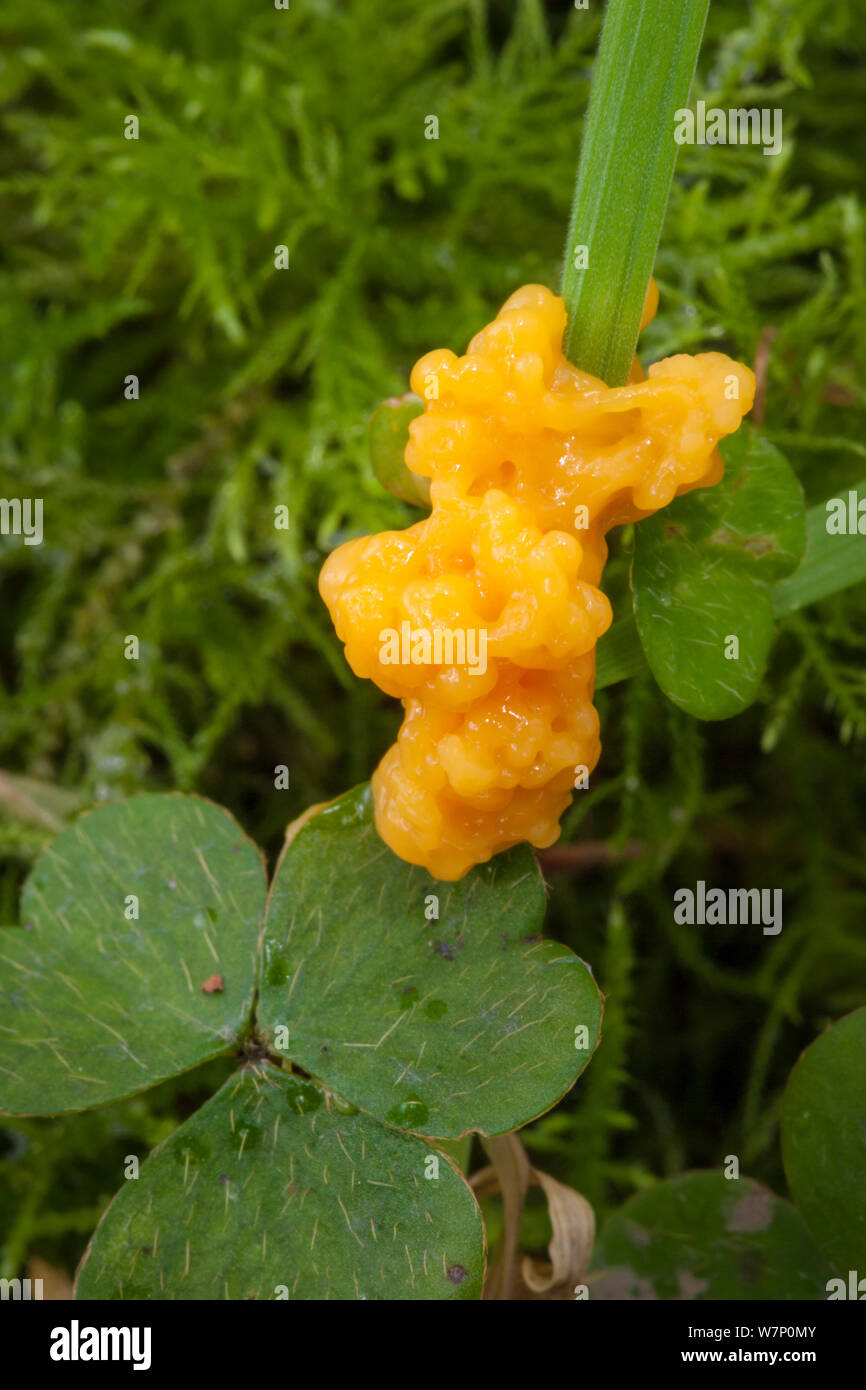 Dog Vomit / Scrambled Egg Slime Mould (Fuligo septica var. septica), a species of plasmodial slime mould (Myxomycetes class). Found on deciduous woodland floor. Peak District National Park, Derbyshire, UK. October. Stock Photohttps://www.alamy.com/image-license-details/?v=1https://www.alamy.com/dog-vomit-scrambled-egg-slime-mould-fuligo-septica-var-septica-a-species-of-plasmodial-slime-mould-myxomycetes-class-found-on-deciduous-woodland-floor-peak-district-national-park-derbyshire-uk-october-image262941643.html
Dog Vomit / Scrambled Egg Slime Mould (Fuligo septica var. septica), a species of plasmodial slime mould (Myxomycetes class). Found on deciduous woodland floor. Peak District National Park, Derbyshire, UK. October. Stock Photohttps://www.alamy.com/image-license-details/?v=1https://www.alamy.com/dog-vomit-scrambled-egg-slime-mould-fuligo-septica-var-septica-a-species-of-plasmodial-slime-mould-myxomycetes-class-found-on-deciduous-woodland-floor-peak-district-national-park-derbyshire-uk-october-image262941643.htmlRMW7P0MY–Dog Vomit / Scrambled Egg Slime Mould (Fuligo septica var. septica), a species of plasmodial slime mould (Myxomycetes class). Found on deciduous woodland floor. Peak District National Park, Derbyshire, UK. October.
 Slime Mould (Trichia decipiens) fruiting bodies on decaying wood. Peak District National Park, Derbyshire, UK. November. Stock Photohttps://www.alamy.com/image-license-details/?v=1https://www.alamy.com/slime-mould-trichia-decipiens-fruiting-bodies-on-decaying-wood-peak-district-national-park-derbyshire-uk-november-image263011744.html
Slime Mould (Trichia decipiens) fruiting bodies on decaying wood. Peak District National Park, Derbyshire, UK. November. Stock Photohttps://www.alamy.com/image-license-details/?v=1https://www.alamy.com/slime-mould-trichia-decipiens-fruiting-bodies-on-decaying-wood-peak-district-national-park-derbyshire-uk-november-image263011744.htmlRMW7W64G–Slime Mould (Trichia decipiens) fruiting bodies on decaying wood. Peak District National Park, Derbyshire, UK. November.
 slime fungus (Myxogastria spec.), on dead wood, Netherlands Stock Photohttps://www.alamy.com/image-license-details/?v=1https://www.alamy.com/slime-fungus-myxogastria-spec-on-dead-wood-netherlands-image255382553.html
slime fungus (Myxogastria spec.), on dead wood, Netherlands Stock Photohttps://www.alamy.com/image-license-details/?v=1https://www.alamy.com/slime-fungus-myxogastria-spec-on-dead-wood-netherlands-image255382553.htmlRMTRDK1D–slime fungus (Myxogastria spec.), on dead wood, Netherlands
![. The North American slime-moulds [microform] : being a list of all species of Myxomycetes hitherto described from North America. Myxomycetes; Myxomycètes. . Please note that these images are extracted from scanned page images that may have been digitally enhanced for readability - coloration and appearance of these illustrations may not perfectly resemble the original work.. Macbride, Thomas Huston, 1848-1934. New York; London : Macmillan Stock Photo . The North American slime-moulds [microform] : being a list of all species of Myxomycetes hitherto described from North America. Myxomycetes; Myxomycètes. . Please note that these images are extracted from scanned page images that may have been digitally enhanced for readability - coloration and appearance of these illustrations may not perfectly resemble the original work.. Macbride, Thomas Huston, 1848-1934. New York; London : Macmillan Stock Photo](https://c8.alamy.com/comp/RJ194Y/the-north-american-slime-moulds-microform-being-a-list-of-all-species-of-myxomycetes-hitherto-described-from-north-america-myxomycetes-myxomyctes-please-note-that-these-images-are-extracted-from-scanned-page-images-that-may-have-been-digitally-enhanced-for-readability-coloration-and-appearance-of-these-illustrations-may-not-perfectly-resemble-the-original-work-macbride-thomas-huston-1848-1934-new-york-london-macmillan-RJ194Y.jpg) . The North American slime-moulds [microform] : being a list of all species of Myxomycetes hitherto described from North America. Myxomycetes; Myxomycètes. . Please note that these images are extracted from scanned page images that may have been digitally enhanced for readability - coloration and appearance of these illustrations may not perfectly resemble the original work.. Macbride, Thomas Huston, 1848-1934. New York; London : Macmillan Stock Photohttps://www.alamy.com/image-license-details/?v=1https://www.alamy.com/the-north-american-slime-moulds-microform-being-a-list-of-all-species-of-myxomycetes-hitherto-described-from-north-america-myxomycetes-myxomyctes-please-note-that-these-images-are-extracted-from-scanned-page-images-that-may-have-been-digitally-enhanced-for-readability-coloration-and-appearance-of-these-illustrations-may-not-perfectly-resemble-the-original-work-macbride-thomas-huston-1848-1934-new-york-london-macmillan-image234827739.html
. The North American slime-moulds [microform] : being a list of all species of Myxomycetes hitherto described from North America. Myxomycetes; Myxomycètes. . Please note that these images are extracted from scanned page images that may have been digitally enhanced for readability - coloration and appearance of these illustrations may not perfectly resemble the original work.. Macbride, Thomas Huston, 1848-1934. New York; London : Macmillan Stock Photohttps://www.alamy.com/image-license-details/?v=1https://www.alamy.com/the-north-american-slime-moulds-microform-being-a-list-of-all-species-of-myxomycetes-hitherto-described-from-north-america-myxomycetes-myxomyctes-please-note-that-these-images-are-extracted-from-scanned-page-images-that-may-have-been-digitally-enhanced-for-readability-coloration-and-appearance-of-these-illustrations-may-not-perfectly-resemble-the-original-work-macbride-thomas-huston-1848-1934-new-york-london-macmillan-image234827739.htmlRMRJ194Y–. The North American slime-moulds [microform] : being a list of all species of Myxomycetes hitherto described from North America. Myxomycetes; Myxomycètes. . Please note that these images are extracted from scanned page images that may have been digitally enhanced for readability - coloration and appearance of these illustrations may not perfectly resemble the original work.. Macbride, Thomas Huston, 1848-1934. New York; London : Macmillan
 Carnival Candy Slime Mold (Arcyria denudata) fruiting bodies (sporangia) grow on a rotting tree. Stock Photohttps://www.alamy.com/image-license-details/?v=1https://www.alamy.com/carnival-candy-slime-mold-arcyria-denudata-fruiting-bodies-sporangia-grow-on-a-rotting-tree-image215557142.html
Carnival Candy Slime Mold (Arcyria denudata) fruiting bodies (sporangia) grow on a rotting tree. Stock Photohttps://www.alamy.com/image-license-details/?v=1https://www.alamy.com/carnival-candy-slime-mold-arcyria-denudata-fruiting-bodies-sporangia-grow-on-a-rotting-tree-image215557142.htmlRMPEKD9A–Carnival Candy Slime Mold (Arcyria denudata) fruiting bodies (sporangia) grow on a rotting tree.
 Group of a slime mold - Stemonitis fusca. It fruits in clusters on dead wood and has distinctive tall brown sporangia supported on slender stalks with Stock Photohttps://www.alamy.com/image-license-details/?v=1https://www.alamy.com/group-of-a-slime-mold-stemonitis-fusca-it-fruits-in-clusters-on-dead-wood-and-has-distinctive-tall-brown-sporangia-supported-on-slender-stalks-with-image622199054.html
Group of a slime mold - Stemonitis fusca. It fruits in clusters on dead wood and has distinctive tall brown sporangia supported on slender stalks with Stock Photohttps://www.alamy.com/image-license-details/?v=1https://www.alamy.com/group-of-a-slime-mold-stemonitis-fusca-it-fruits-in-clusters-on-dead-wood-and-has-distinctive-tall-brown-sporangia-supported-on-slender-stalks-with-image622199054.htmlRF2Y47H6P–Group of a slime mold - Stemonitis fusca. It fruits in clusters on dead wood and has distinctive tall brown sporangia supported on slender stalks with
 Fruiting bodies of Multigoblet Slime Mold (Metatrichia vesparium) grow on the side of a rotting dead tree. Stock Photohttps://www.alamy.com/image-license-details/?v=1https://www.alamy.com/fruiting-bodies-of-multigoblet-slime-mold-metatrichia-vesparium-grow-on-the-side-of-a-rotting-dead-tree-image214720381.html
Fruiting bodies of Multigoblet Slime Mold (Metatrichia vesparium) grow on the side of a rotting dead tree. Stock Photohttps://www.alamy.com/image-license-details/?v=1https://www.alamy.com/fruiting-bodies-of-multigoblet-slime-mold-metatrichia-vesparium-grow-on-the-side-of-a-rotting-dead-tree-image214720381.htmlRMPD9A11–Fruiting bodies of Multigoblet Slime Mold (Metatrichia vesparium) grow on the side of a rotting dead tree.
 Fruiting bodies of Multigoblet Slime Mold (Metatrichia vesparium) grow on the side of a fallen dead tree. Stock Photohttps://www.alamy.com/image-license-details/?v=1https://www.alamy.com/stock-photo-fruiting-bodies-of-multigoblet-slime-mold-metatrichia-vesparium-grow-127410989.html
Fruiting bodies of Multigoblet Slime Mold (Metatrichia vesparium) grow on the side of a fallen dead tree. Stock Photohttps://www.alamy.com/image-license-details/?v=1https://www.alamy.com/stock-photo-fruiting-bodies-of-multigoblet-slime-mold-metatrichia-vesparium-grow-127410989.htmlRMHB820D–Fruiting bodies of Multigoblet Slime Mold (Metatrichia vesparium) grow on the side of a fallen dead tree.
 Slime Mould (Trichia decipiens) fruiting bodies on decaying wood next to pencil lead for scale. Peak District National Park, Derbyshire, UK. November. Stock Photohttps://www.alamy.com/image-license-details/?v=1https://www.alamy.com/slime-mould-trichia-decipiens-fruiting-bodies-on-decaying-wood-next-to-pencil-lead-for-scale-peak-district-national-park-derbyshire-uk-november-image263011740.html
Slime Mould (Trichia decipiens) fruiting bodies on decaying wood next to pencil lead for scale. Peak District National Park, Derbyshire, UK. November. Stock Photohttps://www.alamy.com/image-license-details/?v=1https://www.alamy.com/slime-mould-trichia-decipiens-fruiting-bodies-on-decaying-wood-next-to-pencil-lead-for-scale-peak-district-national-park-derbyshire-uk-november-image263011740.htmlRMW7W64C–Slime Mould (Trichia decipiens) fruiting bodies on decaying wood next to pencil lead for scale. Peak District National Park, Derbyshire, UK. November.
 Fruiting bodies of Multigoblet Slime Mold (Metatrichia vesparium) grow on the side of a fallen dead tree. Stock Photohttps://www.alamy.com/image-license-details/?v=1https://www.alamy.com/fruiting-bodies-of-multigoblet-slime-mold-metatrichia-vesparium-grow-on-the-side-of-a-fallen-dead-tree-image381650583.html
Fruiting bodies of Multigoblet Slime Mold (Metatrichia vesparium) grow on the side of a fallen dead tree. Stock Photohttps://www.alamy.com/image-license-details/?v=1https://www.alamy.com/fruiting-bodies-of-multigoblet-slime-mold-metatrichia-vesparium-grow-on-the-side-of-a-fallen-dead-tree-image381650583.htmlRM2D4WK5Y–Fruiting bodies of Multigoblet Slime Mold (Metatrichia vesparium) grow on the side of a fallen dead tree.
 Slime Mould (Mucilago crustacea) at the plasmodium stage of its lifecycle, found in the corner of a field on wet grass. Peak District National Park, Derbyshire, UK, September. Stock Photohttps://www.alamy.com/image-license-details/?v=1https://www.alamy.com/slime-mould-mucilago-crustacea-at-the-plasmodium-stage-of-its-lifecycle-found-in-the-corner-of-a-field-on-wet-grass-peak-district-national-park-derbyshire-uk-september-image262924011.html
Slime Mould (Mucilago crustacea) at the plasmodium stage of its lifecycle, found in the corner of a field on wet grass. Peak District National Park, Derbyshire, UK, September. Stock Photohttps://www.alamy.com/image-license-details/?v=1https://www.alamy.com/slime-mould-mucilago-crustacea-at-the-plasmodium-stage-of-its-lifecycle-found-in-the-corner-of-a-field-on-wet-grass-peak-district-national-park-derbyshire-uk-september-image262924011.htmlRMW7N677–Slime Mould (Mucilago crustacea) at the plasmodium stage of its lifecycle, found in the corner of a field on wet grass. Peak District National Park, Derbyshire, UK, September.
 Slime mould (Ceratiomyxa fructiculosa) Bolderwood, New Forest National Park, Hampshire, England, UK, November. Stock Photohttps://www.alamy.com/image-license-details/?v=1https://www.alamy.com/slime-mould-ceratiomyxa-fructiculosa-bolderwood-new-forest-national-park-hampshire-england-uk-november-image262915321.html
Slime mould (Ceratiomyxa fructiculosa) Bolderwood, New Forest National Park, Hampshire, England, UK, November. Stock Photohttps://www.alamy.com/image-license-details/?v=1https://www.alamy.com/slime-mould-ceratiomyxa-fructiculosa-bolderwood-new-forest-national-park-hampshire-england-uk-november-image262915321.htmlRMW7MR4W–Slime mould (Ceratiomyxa fructiculosa) Bolderwood, New Forest National Park, Hampshire, England, UK, November.
 Red raspberry slime (Tubifera ferruginosa) Tollymore Forest Park, Newcastle, County Down, Northern Ireland, October. Stock Photohttps://www.alamy.com/image-license-details/?v=1https://www.alamy.com/red-raspberry-slime-tubifera-ferruginosa-tollymore-forest-park-newcastle-county-down-northern-ireland-october-image612077614.html
Red raspberry slime (Tubifera ferruginosa) Tollymore Forest Park, Newcastle, County Down, Northern Ireland, October. Stock Photohttps://www.alamy.com/image-license-details/?v=1https://www.alamy.com/red-raspberry-slime-tubifera-ferruginosa-tollymore-forest-park-newcastle-county-down-northern-ireland-october-image612077614.htmlRM2XFPF6P–Red raspberry slime (Tubifera ferruginosa) Tollymore Forest Park, Newcastle, County Down, Northern Ireland, October.
 Wolf's milk slime mould (Lycogala terrestre). Sussex, England, UK. November. Stock Photohttps://www.alamy.com/image-license-details/?v=1https://www.alamy.com/wolfs-milk-slime-mould-lycogala-terrestre-sussex-england-uk-november-image612152893.html
Wolf's milk slime mould (Lycogala terrestre). Sussex, England, UK. November. Stock Photohttps://www.alamy.com/image-license-details/?v=1https://www.alamy.com/wolfs-milk-slime-mould-lycogala-terrestre-sussex-england-uk-november-image612152893.htmlRM2XFWY79–Wolf's milk slime mould (Lycogala terrestre). Sussex, England, UK. November.
 slime fungus (Myxogastria spec.), on dead wood, Netherlands Stock Photohttps://www.alamy.com/image-license-details/?v=1https://www.alamy.com/slime-fungus-myxogastria-spec-on-dead-wood-netherlands-image255382548.html
slime fungus (Myxogastria spec.), on dead wood, Netherlands Stock Photohttps://www.alamy.com/image-license-details/?v=1https://www.alamy.com/slime-fungus-myxogastria-spec-on-dead-wood-netherlands-image255382548.htmlRMTRDK18–slime fungus (Myxogastria spec.), on dead wood, Netherlands
 Dog vomit slime mould (Fuligo septica). Sussex, England, UK. October. Stock Photohttps://www.alamy.com/image-license-details/?v=1https://www.alamy.com/dog-vomit-slime-mould-fuligo-septica-sussex-england-uk-october-image612152898.html
Dog vomit slime mould (Fuligo septica). Sussex, England, UK. October. Stock Photohttps://www.alamy.com/image-license-details/?v=1https://www.alamy.com/dog-vomit-slime-mould-fuligo-septica-sussex-england-uk-october-image612152898.htmlRM2XFWY7E–Dog vomit slime mould (Fuligo septica). Sussex, England, UK. October.
 Slime mould (Fuligo septica) Annagarrif Wood NNR, Peatlands, County Armagh, Northern Ireland, September. Stock Photohttps://www.alamy.com/image-license-details/?v=1https://www.alamy.com/slime-mould-fuligo-septica-annagarrif-wood-nnr-peatlands-county-armagh-northern-ireland-september-image612093033.html
Slime mould (Fuligo septica) Annagarrif Wood NNR, Peatlands, County Armagh, Northern Ireland, September. Stock Photohttps://www.alamy.com/image-license-details/?v=1https://www.alamy.com/slime-mould-fuligo-septica-annagarrif-wood-nnr-peatlands-county-armagh-northern-ireland-september-image612093033.htmlRM2XFR6WD–Slime mould (Fuligo septica) Annagarrif Wood NNR, Peatlands, County Armagh, Northern Ireland, September.
![. The North American slime-moulds [microform] : being a list of all species of Myxomycetes hitherto described from North America. Myxomycetes; Myxomycètes. . Please note that these images are extracted from scanned page images that may have been digitally enhanced for readability - coloration and appearance of these illustrations may not perfectly resemble the original work.. Macbride, Thomas Huston, 1848-1934. New York; London : Macmillan Stock Photo . The North American slime-moulds [microform] : being a list of all species of Myxomycetes hitherto described from North America. Myxomycetes; Myxomycètes. . Please note that these images are extracted from scanned page images that may have been digitally enhanced for readability - coloration and appearance of these illustrations may not perfectly resemble the original work.. Macbride, Thomas Huston, 1848-1934. New York; London : Macmillan Stock Photo](https://c8.alamy.com/comp/RJ1972/the-north-american-slime-moulds-microform-being-a-list-of-all-species-of-myxomycetes-hitherto-described-from-north-america-myxomycetes-myxomyctes-please-note-that-these-images-are-extracted-from-scanned-page-images-that-may-have-been-digitally-enhanced-for-readability-coloration-and-appearance-of-these-illustrations-may-not-perfectly-resemble-the-original-work-macbride-thomas-huston-1848-1934-new-york-london-macmillan-RJ1972.jpg) . The North American slime-moulds [microform] : being a list of all species of Myxomycetes hitherto described from North America. Myxomycetes; Myxomycètes. . Please note that these images are extracted from scanned page images that may have been digitally enhanced for readability - coloration and appearance of these illustrations may not perfectly resemble the original work.. Macbride, Thomas Huston, 1848-1934. New York; London : Macmillan Stock Photohttps://www.alamy.com/image-license-details/?v=1https://www.alamy.com/the-north-american-slime-moulds-microform-being-a-list-of-all-species-of-myxomycetes-hitherto-described-from-north-america-myxomycetes-myxomyctes-please-note-that-these-images-are-extracted-from-scanned-page-images-that-may-have-been-digitally-enhanced-for-readability-coloration-and-appearance-of-these-illustrations-may-not-perfectly-resemble-the-original-work-macbride-thomas-huston-1848-1934-new-york-london-macmillan-image234827798.html
. The North American slime-moulds [microform] : being a list of all species of Myxomycetes hitherto described from North America. Myxomycetes; Myxomycètes. . Please note that these images are extracted from scanned page images that may have been digitally enhanced for readability - coloration and appearance of these illustrations may not perfectly resemble the original work.. Macbride, Thomas Huston, 1848-1934. New York; London : Macmillan Stock Photohttps://www.alamy.com/image-license-details/?v=1https://www.alamy.com/the-north-american-slime-moulds-microform-being-a-list-of-all-species-of-myxomycetes-hitherto-described-from-north-america-myxomycetes-myxomyctes-please-note-that-these-images-are-extracted-from-scanned-page-images-that-may-have-been-digitally-enhanced-for-readability-coloration-and-appearance-of-these-illustrations-may-not-perfectly-resemble-the-original-work-macbride-thomas-huston-1848-1934-new-york-london-macmillan-image234827798.htmlRMRJ1972–. The North American slime-moulds [microform] : being a list of all species of Myxomycetes hitherto described from North America. Myxomycetes; Myxomycètes. . Please note that these images are extracted from scanned page images that may have been digitally enhanced for readability - coloration and appearance of these illustrations may not perfectly resemble the original work.. Macbride, Thomas Huston, 1848-1934. New York; London : Macmillan
 Wolf's Milk, Plasmodial slime mould, (Lycogala terrestre), brown phase, on dead ash, Ancient Semi-natural Woodland, Herefordshire Plateau, England. Stock Photohttps://www.alamy.com/image-license-details/?v=1https://www.alamy.com/wolfs-milk-plasmodial-slime-mould-lycogala-terrestre-brown-phase-on-dead-ash-ancient-semi-natural-woodland-herefordshire-plateau-england-image612093747.html
Wolf's Milk, Plasmodial slime mould, (Lycogala terrestre), brown phase, on dead ash, Ancient Semi-natural Woodland, Herefordshire Plateau, England. Stock Photohttps://www.alamy.com/image-license-details/?v=1https://www.alamy.com/wolfs-milk-plasmodial-slime-mould-lycogala-terrestre-brown-phase-on-dead-ash-ancient-semi-natural-woodland-herefordshire-plateau-england-image612093747.htmlRM2XFR7PY–Wolf's Milk, Plasmodial slime mould, (Lycogala terrestre), brown phase, on dead ash, Ancient Semi-natural Woodland, Herefordshire Plateau, England.
 Wolf's Milk, Plasmodial slime mould, (Lycogala terrestre), orange phase, on dead ash, Ancient Semi-natural Woodland, Herefordshire Plateau, England. Stock Photohttps://www.alamy.com/image-license-details/?v=1https://www.alamy.com/wolfs-milk-plasmodial-slime-mould-lycogala-terrestre-orange-phase-on-dead-ash-ancient-semi-natural-woodland-herefordshire-plateau-england-image612093730.html
Wolf's Milk, Plasmodial slime mould, (Lycogala terrestre), orange phase, on dead ash, Ancient Semi-natural Woodland, Herefordshire Plateau, England. Stock Photohttps://www.alamy.com/image-license-details/?v=1https://www.alamy.com/wolfs-milk-plasmodial-slime-mould-lycogala-terrestre-orange-phase-on-dead-ash-ancient-semi-natural-woodland-herefordshire-plateau-england-image612093730.htmlRM2XFR7PA–Wolf's Milk, Plasmodial slime mould, (Lycogala terrestre), orange phase, on dead ash, Ancient Semi-natural Woodland, Herefordshire Plateau, England.
 Wolf's Milk, Plasmodial slime mould, (Lycogala terrestre), brown phase and orange phase, on dead ash, Ancient Semi-natural Woodland, Herefordshire Plateau, England. Stock Photohttps://www.alamy.com/image-license-details/?v=1https://www.alamy.com/wolfs-milk-plasmodial-slime-mould-lycogala-terrestre-brown-phase-and-orange-phase-on-dead-ash-ancient-semi-natural-woodland-herefordshire-plateau-england-image612093758.html
Wolf's Milk, Plasmodial slime mould, (Lycogala terrestre), brown phase and orange phase, on dead ash, Ancient Semi-natural Woodland, Herefordshire Plateau, England. Stock Photohttps://www.alamy.com/image-license-details/?v=1https://www.alamy.com/wolfs-milk-plasmodial-slime-mould-lycogala-terrestre-brown-phase-and-orange-phase-on-dead-ash-ancient-semi-natural-woodland-herefordshire-plateau-england-image612093758.htmlRM2XFR7RA–Wolf's Milk, Plasmodial slime mould, (Lycogala terrestre), brown phase and orange phase, on dead ash, Ancient Semi-natural Woodland, Herefordshire Plateau, England.
 Slime mould (Arcyria sp), Intervales State Park, Sao Paulo, Atlantic Forest South-East Reserves, UNESCO World Heritage Site, Brazil. Stock Photohttps://www.alamy.com/image-license-details/?v=1https://www.alamy.com/slime-mould-arcyria-sp-intervales-state-park-sao-paulo-atlantic-forest-south-east-reserves-unesco-world-heritage-site-brazil-image612153146.html
Slime mould (Arcyria sp), Intervales State Park, Sao Paulo, Atlantic Forest South-East Reserves, UNESCO World Heritage Site, Brazil. Stock Photohttps://www.alamy.com/image-license-details/?v=1https://www.alamy.com/slime-mould-arcyria-sp-intervales-state-park-sao-paulo-atlantic-forest-south-east-reserves-unesco-world-heritage-site-brazil-image612153146.htmlRM2XFWYGA–Slime mould (Arcyria sp), Intervales State Park, Sao Paulo, Atlantic Forest South-East Reserves, UNESCO World Heritage Site, Brazil.
 Dog vomit slime mold (Fuligo septica) and slug on moss. Annagarriff Wood National Nature Reserve, Peatlands Park, County Armagh, Northern Ireland. August. Stock Photohttps://www.alamy.com/image-license-details/?v=1https://www.alamy.com/dog-vomit-slime-mold-fuligo-septica-and-slug-on-moss-annagarriff-wood-national-nature-reserve-peatlands-park-county-armagh-northern-ireland-august-image612159816.html
Dog vomit slime mold (Fuligo septica) and slug on moss. Annagarriff Wood National Nature Reserve, Peatlands Park, County Armagh, Northern Ireland. August. Stock Photohttps://www.alamy.com/image-license-details/?v=1https://www.alamy.com/dog-vomit-slime-mold-fuligo-septica-and-slug-on-moss-annagarriff-wood-national-nature-reserve-peatlands-park-county-armagh-northern-ireland-august-image612159816.htmlRM2XFX82G–Dog vomit slime mold (Fuligo septica) and slug on moss. Annagarriff Wood National Nature Reserve, Peatlands Park, County Armagh, Northern Ireland. August.
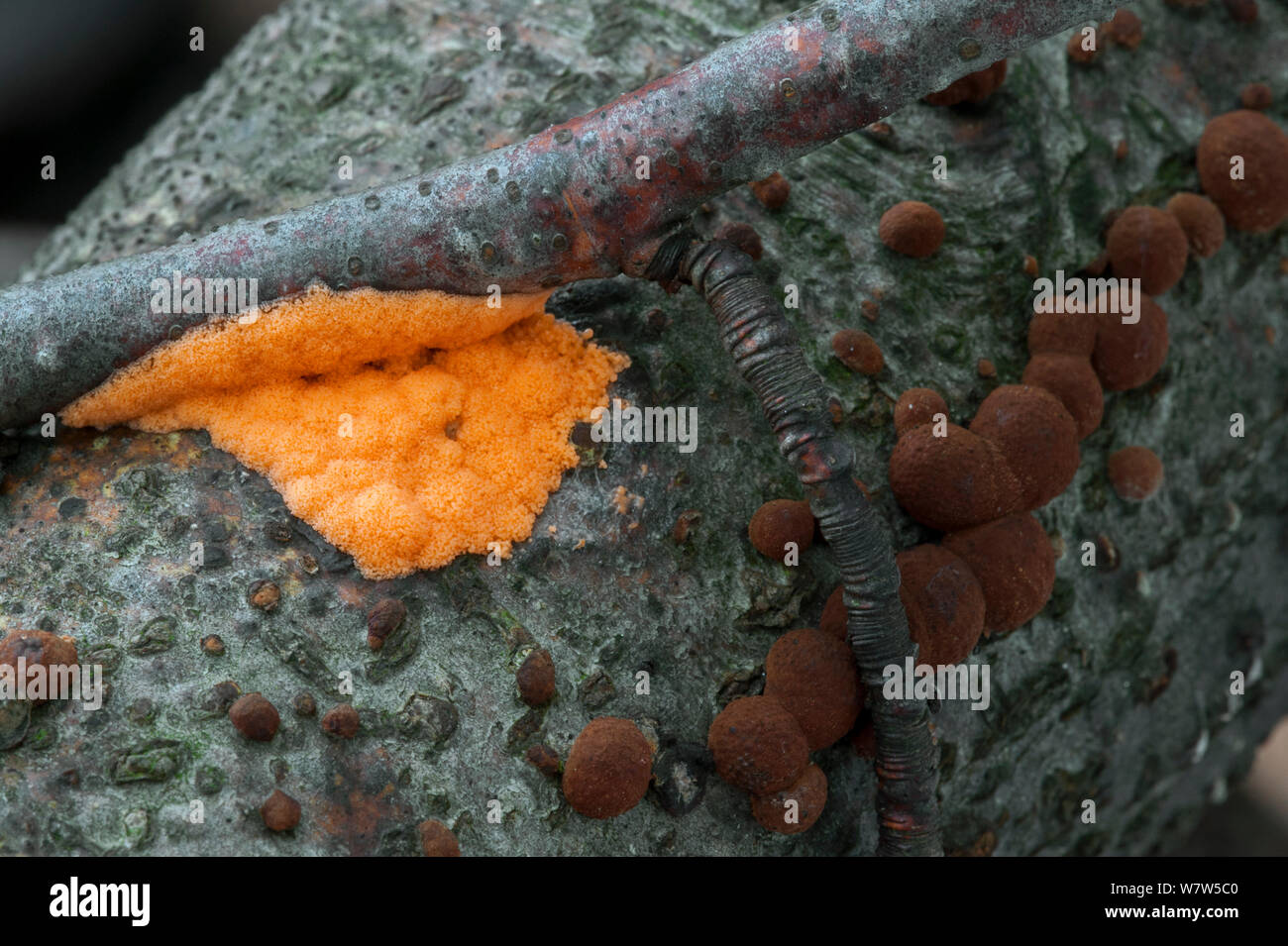 Slime mold (Dictydiaethalium plumbeum) and Beech woodwart (Hypoxylon fragiforme) growing on a branch, Belgium, October. Stock Photohttps://www.alamy.com/image-license-details/?v=1https://www.alamy.com/slime-mold-dictydiaethalium-plumbeum-and-beech-woodwart-hypoxylon-fragiforme-growing-on-a-branch-belgium-october-image263011168.html
Slime mold (Dictydiaethalium plumbeum) and Beech woodwart (Hypoxylon fragiforme) growing on a branch, Belgium, October. Stock Photohttps://www.alamy.com/image-license-details/?v=1https://www.alamy.com/slime-mold-dictydiaethalium-plumbeum-and-beech-woodwart-hypoxylon-fragiforme-growing-on-a-branch-belgium-october-image263011168.htmlRMW7W5C0–Slime mold (Dictydiaethalium plumbeum) and Beech woodwart (Hypoxylon fragiforme) growing on a branch, Belgium, October.
 slime fungus (Myxogastria spec.), on dead wood, Netherlands Stock Photohttps://www.alamy.com/image-license-details/?v=1https://www.alamy.com/slime-fungus-myxogastria-spec-on-dead-wood-netherlands-image255382545.html
slime fungus (Myxogastria spec.), on dead wood, Netherlands Stock Photohttps://www.alamy.com/image-license-details/?v=1https://www.alamy.com/slime-fungus-myxogastria-spec-on-dead-wood-netherlands-image255382545.htmlRMTRDK15–slime fungus (Myxogastria spec.), on dead wood, Netherlands
![. The North American slime-moulds [microform] : being a list of all species of Myxomycetes hitherto described from North America. Myxomycetes; Myxomycètes. . Please note that these images are extracted from scanned page images that may have been digitally enhanced for readability - coloration and appearance of these illustrations may not perfectly resemble the original work.. Macbride, Thomas Huston, 1848-1934. New York; London : Macmillan Stock Photo . The North American slime-moulds [microform] : being a list of all species of Myxomycetes hitherto described from North America. Myxomycetes; Myxomycètes. . Please note that these images are extracted from scanned page images that may have been digitally enhanced for readability - coloration and appearance of these illustrations may not perfectly resemble the original work.. Macbride, Thomas Huston, 1848-1934. New York; London : Macmillan Stock Photo](https://c8.alamy.com/comp/RJ1988/the-north-american-slime-moulds-microform-being-a-list-of-all-species-of-myxomycetes-hitherto-described-from-north-america-myxomycetes-myxomyctes-please-note-that-these-images-are-extracted-from-scanned-page-images-that-may-have-been-digitally-enhanced-for-readability-coloration-and-appearance-of-these-illustrations-may-not-perfectly-resemble-the-original-work-macbride-thomas-huston-1848-1934-new-york-london-macmillan-RJ1988.jpg) . The North American slime-moulds [microform] : being a list of all species of Myxomycetes hitherto described from North America. Myxomycetes; Myxomycètes. . Please note that these images are extracted from scanned page images that may have been digitally enhanced for readability - coloration and appearance of these illustrations may not perfectly resemble the original work.. Macbride, Thomas Huston, 1848-1934. New York; London : Macmillan Stock Photohttps://www.alamy.com/image-license-details/?v=1https://www.alamy.com/the-north-american-slime-moulds-microform-being-a-list-of-all-species-of-myxomycetes-hitherto-described-from-north-america-myxomycetes-myxomyctes-please-note-that-these-images-are-extracted-from-scanned-page-images-that-may-have-been-digitally-enhanced-for-readability-coloration-and-appearance-of-these-illustrations-may-not-perfectly-resemble-the-original-work-macbride-thomas-huston-1848-1934-new-york-london-macmillan-image234827832.html
. The North American slime-moulds [microform] : being a list of all species of Myxomycetes hitherto described from North America. Myxomycetes; Myxomycètes. . Please note that these images are extracted from scanned page images that may have been digitally enhanced for readability - coloration and appearance of these illustrations may not perfectly resemble the original work.. Macbride, Thomas Huston, 1848-1934. New York; London : Macmillan Stock Photohttps://www.alamy.com/image-license-details/?v=1https://www.alamy.com/the-north-american-slime-moulds-microform-being-a-list-of-all-species-of-myxomycetes-hitherto-described-from-north-america-myxomycetes-myxomyctes-please-note-that-these-images-are-extracted-from-scanned-page-images-that-may-have-been-digitally-enhanced-for-readability-coloration-and-appearance-of-these-illustrations-may-not-perfectly-resemble-the-original-work-macbride-thomas-huston-1848-1934-new-york-london-macmillan-image234827832.htmlRMRJ1988–. The North American slime-moulds [microform] : being a list of all species of Myxomycetes hitherto described from North America. Myxomycetes; Myxomycètes. . Please note that these images are extracted from scanned page images that may have been digitally enhanced for readability - coloration and appearance of these illustrations may not perfectly resemble the original work.. Macbride, Thomas Huston, 1848-1934. New York; London : Macmillan
 Slime mold (Dictydiaethalium plumbeum) and Beech woodwart (Hypoxylon fragiforme) growing on a branch, Belgium, October. Stock Photohttps://www.alamy.com/image-license-details/?v=1https://www.alamy.com/slime-mold-dictydiaethalium-plumbeum-and-beech-woodwart-hypoxylon-fragiforme-growing-on-a-branch-belgium-october-image263011172.html
Slime mold (Dictydiaethalium plumbeum) and Beech woodwart (Hypoxylon fragiforme) growing on a branch, Belgium, October. Stock Photohttps://www.alamy.com/image-license-details/?v=1https://www.alamy.com/slime-mold-dictydiaethalium-plumbeum-and-beech-woodwart-hypoxylon-fragiforme-growing-on-a-branch-belgium-october-image263011172.htmlRMW7W5C4–Slime mold (Dictydiaethalium plumbeum) and Beech woodwart (Hypoxylon fragiforme) growing on a branch, Belgium, October.
 Acellular Slime Mould, 'Many headed slime' (Physarum polycephalum) Stock Photohttps://www.alamy.com/image-license-details/?v=1https://www.alamy.com/stock-photo-acellular-slime-mould-many-headed-slime-physarum-polycephalum-71427414.html
Acellular Slime Mould, 'Many headed slime' (Physarum polycephalum) Stock Photohttps://www.alamy.com/image-license-details/?v=1https://www.alamy.com/stock-photo-acellular-slime-mould-many-headed-slime-physarum-polycephalum-71427414.htmlRME45PB2–Acellular Slime Mould, 'Many headed slime' (Physarum polycephalum)
